Jane Rule - & Other Scary Lesbians Charmers
Friday, November 30, 2007
It wasnt't too long ago that I wrote this. I put it here again in memory of a woman who charmed me and whom I will not forget. Rest in piece, Jane Rule.
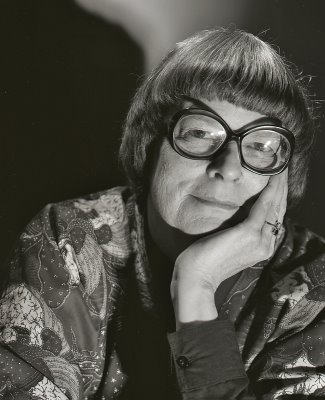
Sometime in April 1991 the editor of Quill & Quire called me up and said, "Alex how would you like to photograph a 6 ft tall lesbian?" I was speechless, even after he said, "Your subject is going to be writer Jane Rule. The piece on her is that she is going to retire from writing because of her terrible arthritis which prevents her from articulating her fingers."
I did not know what to expect as I waited for her to show up.
In 1978 I had photographed a woman for a gay publication called Bi-Line. She was extremely beautiful and she was a lesbian who was treated by other women as a queen bee. They vied for who would wash her car or clean her house. She was obvious royalty. We met for coffee to dicuss our photo session and decided on dressing her in her karate clothing and I would photograph her after her workout. As I listened and stared at the woman I felt this incredible relaxation that as a man I did not have to worry about my sexuality, to make any kind of passes and I could just be myself. It was a liberating feeling.
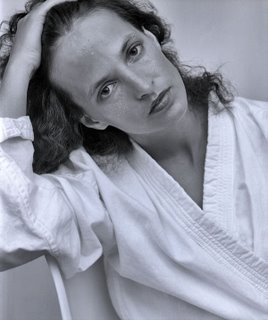
With that in mind I did not expect to be woowed and wowed by Jane Rule. I fell for her immediately as she posed for me with her owl glasses. She had a delightful dress and she carried herself well considering she was big woman. At the end of our session she said to me, "Alex, I will need your help to go down the stairs and I would like you to find me a cab." As we walked down the stairs hand in hand I thought of that cliche that applied so well to the situation:
A lady is a woman that makes a man feel like a gentleman.
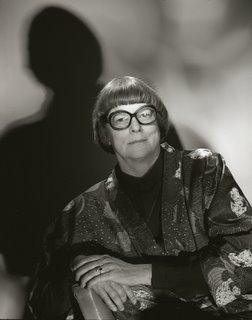
Carmen Aguirre - Vancouver Bombshell, Actor, Director, Playwright
Thursday, November 29, 2007
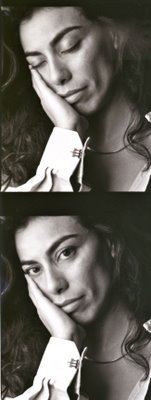
It seems that it has been a long time since I last sat in a bar with friends Les Wiseman and John Lekich and discussed our favourite topic, beautiful women. We would ignore the exotic dancers performing in such downtown bars as the Austin or the Cecil and write our top ten lists of the most beautiful women in the world or in Vancouver. More often than not Lekich would have a list of women of which the majority had been dead (Grace Kelly, Audrey Hepburn, Barbara Stanwyck) for years. Wiseman, who was more into the media and esoteric magazines, would name unknown (to us) body builders and porn stars. We always had a fondness for our Vancouver Top Ten. If we were to repeat these sessions I would immediately place Carmen Aguirre on the top of the list.
I first wrote about her here but on Monday when I wrote my blog on the Vancouver East Cultural Centre. I had a chance to look into my Carmen Aguirre files. I photographed her many times. The first time it was for the Georgia Straight in 1999 when Aguirre was directing a play she had written about Latinos ¿Qué pasa con la Raza, eh? which was going to open at the Firehall Theatre.
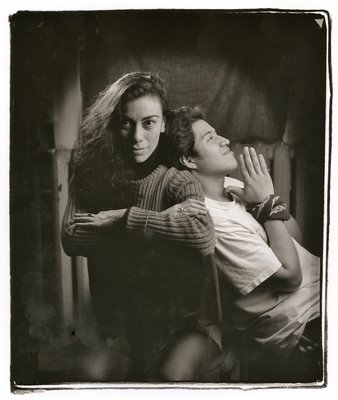
I photographed her with actor Oparín Ortiz (right). After almost 24 years in Vancouver I had forgotten the sex appeal (a visceral impact) of a Latino (Aguirre was born in Chile) woman. Aguirre was wearing a killer mini skirt and had legs that kept me speechless for most of the photographic session.
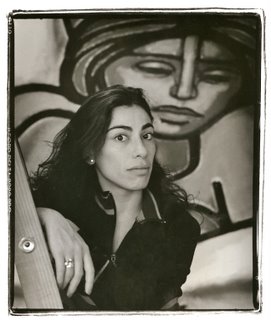
Through our mutual friends, the Argentine painters Juan Manuel Sanchez and Nora Patrich, (one of the pictures here features one of Sanchez's murals) I photographed her many times. My favourite sessions involved pictures of her with the cast of the Electric Theatre Company's production in 2002 of Donna Flor and her Two Husbands.
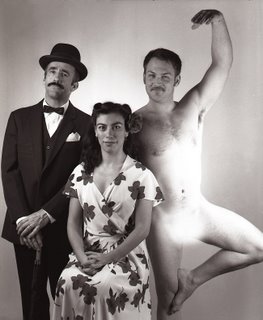
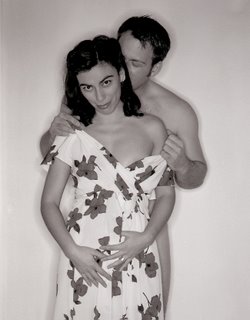
Carmen Aguirre is an actor, a director and a very good playwright. My favourite play of hers was an adaptation of one of Argentine novelist Julio Cortazar's most famous short stories Final del Juego (The End Of The Game) into a play in English which opened in Langara's Studio 56 in November 2003.
One of Aguirre's most endearing qualities after an infectuous laugh is her candor. During a cast shoot for one of her plays that I was shooting in my studio she said, clearly in her beautiful Spanish, "Size does matter." Whatever plans I might have had to divorce my wife and propose marriage to her were all but quashed
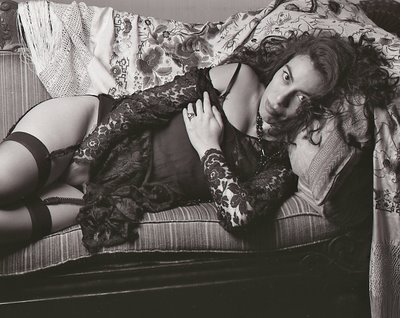
Wednesday, November 28, 2007
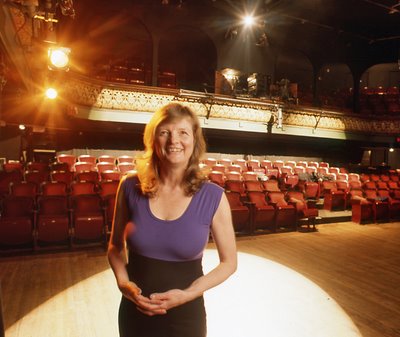
Last night my wife Rosemary and I went to Kidd Pivot's Lost Action at the Vancouver East Cultural Centre. This was the first time Rosemary has ever seen dance that is not ballet and she was a bit overwhelmed. She is not a veteran as Rebecca is who would not have been fazed in the least by the almost brutal and constant movement of the 7dancers for one hour and twenty minutes.
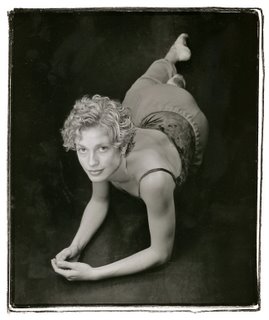
We noticed among all the people that I know (many from the dance community ready to check out the latest from Kidd Pivot's Crystal Pite, left) Arthur Erickson (83, below) who helped by his driver Ray managed to find himself a seat in the balcony.
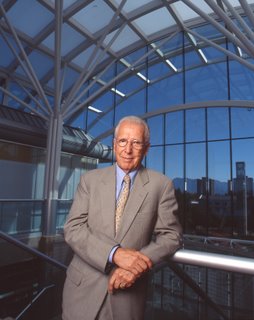
When I greeted him after the performance he gesticulated enthusiastically with his hands and said, "Wonderful!"
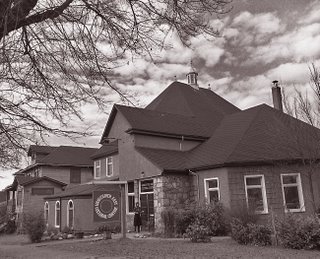
Because it was opening night there was food served. They had some special corn mufins that packed a bang as they had jalapeño peppers inside. But Rosemary, who noticed all the construction (part of the millions of dollars renovation of the old Methodist church) particularly in what used to be the parking lot (there is a big hole), asked me if the place would remain as it is. I asked Heather Redfern (top left), the present Executive Director who calmed us, "You won't notice anything but the toilets will flush!" This comforted us. The Vancouver Cultural Centre has entertained us, thrilled us, challenged us (just think of Chick Snipper's Slab) all these years.
I particularly remember the Modern Baroque Opera's (please come back!)production of the 120 Songs for the Marquis de Sade which like last night's Lost Action was an ALCAN Award production. This opera had elements of the Pacific Baroque Orchestra playing on the floor next to the performers.
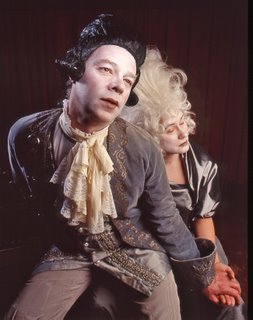
The theatre has no orchestra pit. This meant that not only were we able to see the singers but also musicians. It was a wonderful and intimate combination. "No, we are not going to put an orchestra pit," Redfern said to us. I did not raise the issue with Redfern as to how it felt being on the front row with a naked Marquis de Sade (Michael Douglas Jones with Christine Duncan as the Countess) swinging it back and forth not four ft away.
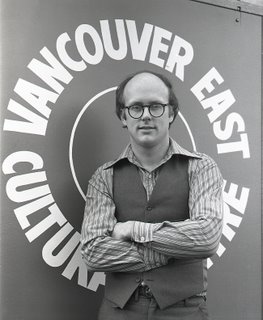
The second person I ever photographed inside the VECC (I photographed the first Executive Director Chris Wooten sometime in 1978, inside and outside as seen here) was a broadcaster who had just arrived to Vancouver via her old home in England. Her name was Vicki Gabereau.
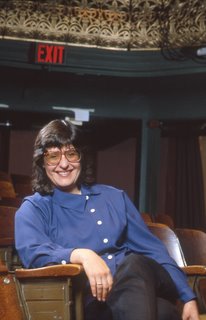
Something very special about the VECC is that they are perhaps the only cultural institution (besides the Firehall Theatre) that features and caters to dance, theatre, music and the visual arts regularly. The lobby always has some sort of show of paintings or sculpture. I have heard many concerts of new music. It was here that I discovered the virtuosity of jazz man Brad Turner who in an avant-garde piece played his trumpet (accompanied by a percussionist) for almost 6 minutes without ever really playing a note. He made noises with the valves, etc while hiding his face with a brimmed hat.
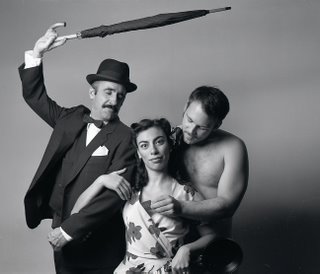
I was in 2001 that the VECC started a tradition. The Electric Company Theatre's Dona Flor's And Her Two Husbands premiered with Carmen Aguirre, the extremly funny faux basoonist Don Adams and actor Ty Olsson who in all his time on stage (most of the time) wore absolutely nothing and dangled. Halfway through the production Aguirre made it equal time and shed her clothes.
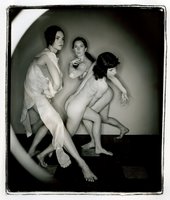
True to this tradition, VECC features full nudity or partial nudity at least once a year. To this day when I cite Chick Snipper's Slab (2003)in the presence of Rebecca (she was 6 then) she says, "They wore nothing." In the photo below that's Kathleen McDonagh, Ann Cooper center back and Susan Elliott, centre.
As we went home last night I thought that Vancouver without the VECC would be a very poor place. And thanks to the VECC's existence it is that much better. I then caught another VECC memory, those four microphones decorated with pink ribbon. Does anybody remember?
The only two things that people remember about Vancouver is that Malcolm Lowry lived and Errol Flynn died here.
John Lekich
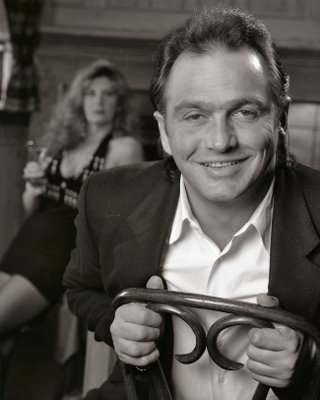
The most important change that Expo 86 brought to Vancouver was a more realistic liquor law. Prior to Expo 86, La Bodega on Howe was the only restaurant where you could stare at a salad all day and drink yourself to oblivion, even on a Sunday. For years I had watched people get drunk on coffee at the Classical Joint on Carral Street. It took me a while to figure out that patrons would whisper, when asked what they wanted, "A dark coffee." This concoction people said had Irish whiskey. Before Expo 86, Tony Ricci was sitting pretty with his Marble Arch Hotel. It had a liquor license that had the latest closing hours in Vancouver (2 am). Those who would fortify their evenings with High Test at the Smilin' Buddha on East Hastings and ejected by bouncer Igor at 1 am, would run to the Arch for more.
In 1995 the exotic dancer bar craze of Vancouver was beginning to wane. But again, Ricci was sitting pretty as the unsigned owner of the NBI (the North Burnaby Inn) on East Hastings. It had the largest and best liquor and off sale license East of Boundary. It had a huge room with a stage where the city's best strippers performed. It was the only strip bar in Burnaby (besides the Lougheed Motel on Willingdon). The NBI was doing just fine. But there was another room, sort of like a pub, that never had customers except terminal city alcoholics.
This is when a man who does not profiit from selling New York landmarks because he lives in Vancouver, poet Michael Turner, went up to Ricci and suggested that the room be converted to a Mecca for poetry.
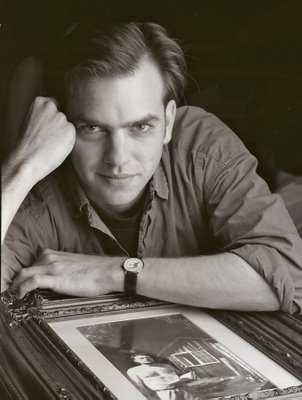
He thought that it should be called the Malcolm Lowry Room. And so it was. Malcolm Lowry Room opened its doors, prominently decorated with a beautifully framed portrait of Lowry by his shack on Cates Park on the other side of Burrard Inlet near Deep Cove. Turner then (I am almost sure) started rumours that Lowry (reported to be a fine swimmer) had braved the waters of Burrard Inlet, desperate for gin or two at the bar that was in the exact same spot where the NBI was.
At about that time writer John Lekich, no worse than Turner in his ability to persuade, pitched the story of the Malcolm Lowry Room to editor Charles Campbell at the Georgia Straight. I was dispatched to take the pictures and told it was a cover story.
I rounded up my equipment, and before I left, I went to my book shelves in search of my Book-of-the-Month Club copy of Lowry's Under the Volcano. After taking my portrait of Ricci (barmaid behind him), Michael Turner (with the framed photograph of Lowry) I used the book for the cover shot involving Turner and a barmaid. We picked one who was not as well endowed as most of the others who worked there. We didn't want the picture to be rejected by the Straight which was beefing up its moral standards.
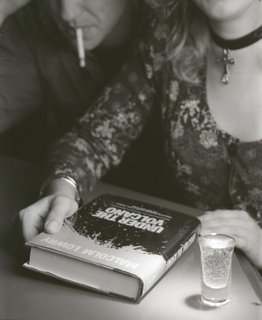
Before I left I went up to Ricci and told him, "Tony, here is Malcolm Lowry's famous novel. Keep it under the bar in case anybody asks." His reply was his usual one, "Alex, I owe you big." And he always meant that.

If you happen to see yesterday's blog you might note the picture of rebecca that I repeat here (left). It almost didn't happen.
On Friday afternoon I asked Rosemary to call Hilary to ask Rebecca to wear black for our Ballet BC date that evening. She was to tell Hilary that I was dressing in black. When Rebecca goes to her Wednesday ballet class she wears a black leotard, a little dark purple (almost black) short skirt, a black top and she wears her hair up. I love her like that and that was what I wanted her to wear. That was not to be.
When I picked her up she was wearing a new dress given to her by her Nana (her other grandmother). Holding on to Lilly the cat she looked lovely. Because her digital camera was not working I was not able to take her picture with Simone Orlando back stage after the ballet. I decided I was going to photograph her in my studio the next day.
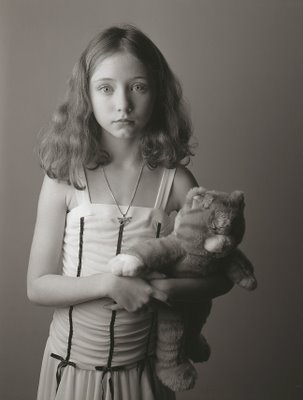
When a photographer uses more than one speed film at the same time, mistakes happen. I shot a roll (above) using the beautiful capabilities of the now discontinued Kodak Technical Pan in 120 which has a speed of 25 ISO. After I exposed the 10 shots (that's a complete roll with my Mamiya RB) I noticed that the roll was not Technical Pan but my usual Plus-X Pan with an ISO of 100. This meant that I had overexposed it by two stops. I took some pictures again with Technical Pan and tried to repeat the same poses. After that I shot a second roll of Plus-X (correctly exposed) of Rebecca doing other poses with Lilly and without.
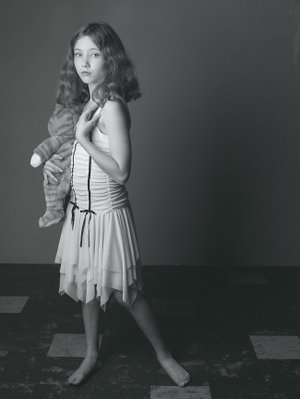
I worsened the problem by putting all three rolls into my bag so that when I realized what I had done I could not tell which was the bad roll. Last night I played it safe and processed one roll of Plus-X. It was perfectly exposed. This meant that the second one was the one.
That roll I underdeveloped with a much diluted developer (HC-110) and the results were excellent, that's the second picture above.
Taking photographs of Rebecca, who is a veteran, is a pleasure. She must be older than her age when she asked me if she had beautiful feet. I had indicated to her to take off her shoes for the full-length shots. I told her that yes, and that both my mother and I had beautiful feet and that she had inherited from us.
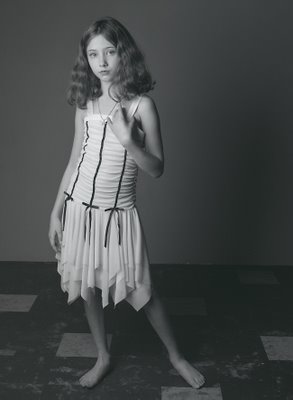
I was charmed when she talked to Lilly, "I want some pictures without you so I hope you don't mind." Rebecca put Lilly on a table and posed for me. And from now on I will not tell Rebecca what to wear. I will let her surprise me.
But the man who comes back through the Door in the Wall will never be quite the same man who went out. He will be wiser but less cocksure, happier but less self-satisfied, humbler in acknowledging his ignorance yet better equipped to understand the relationship of words to things, of systematic reasoning to the unfathomable Mystery which it tries, forever vainly to comprehend.
The Doors of Perception - Aldous Huxley
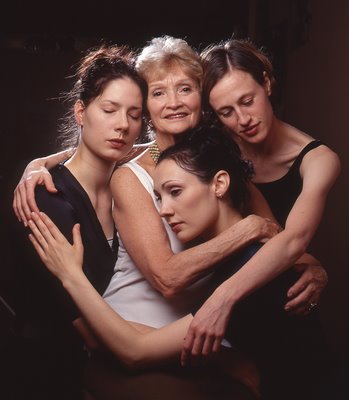
Friday Night Rebecca and I attended a performance of Ballet BC called Elemental Brubeck An Evening With Jazz. It featured three works. The first was Serge Bennathan's In and Around Kozla Street, the second was a premiere of Simon Orlando's Realm of Her Eclipse. The third was Lar Luvobitch's Elemental Brubeck.
In and Around Kozla Street
I am unable to see this sad piece without thinking of two other previous performances, years back, by Ballet BC. One featured Crystal Pite and her beau Jay Gower Taylor. This is when I first noticed (hard not to!)an embrace where the couple kiss and keep dancing. I didn't time it then but it felt like two minutes. The second occasion, January 22, 1988, was my favourite as it featured red haird Lauri Stallings and the most electryfing man that ever danced for Ballet BC, Mirsoslav Zydowicz (below brushing artist Tiko Kerr).
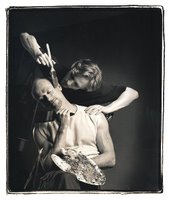
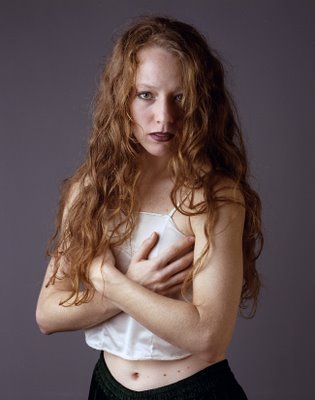
As I watched Lauri Stallings and Mirsoslav Zydowicz twirl around and around - their lips seemingly glued together - I asked Rosemary how long she thought the kiss was and, I had a revelation, which I whispered to my wife Rosemary: "Ballet is about sex." She hushed me, pointing out that Stallings' boyfriend, Rick Carvlin, was sitting next to us. He had heard me. "They kiss for one minute and 58 seconds," he said. "I have timed them before." Lauri Stallings more so because of her red hair and a very prsonal style imposed a fiery passion.
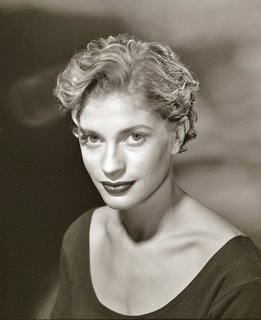
Crystal Pite (left) had been more ethereal, more tender.
Friday evening's was different too. Alexis Fletcher (bottom, right, alumni of Arts Umbrella) danced with James Gnam. Because of Fletcher's youth it felt like a first time kiss.
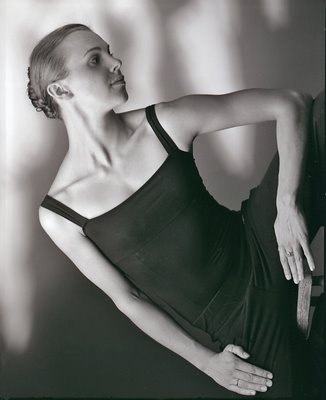
It was wonderful to watch. And it was wonderful to watch (Rebecca commented on how she liked her) this dancer, who in spite of Makaila Wallace's performance that evening as the lead in Orlando's ballet, has to be the dancer to watch in Ballet BC.
At the intermission Rebecca wandered to a small table where ballet paraphernalia was being sold. I spotted Ballet BC Founding President Jean Orr (universally adored). She always greets me with her smile and I always want to embrace and kiss her. This I did. Meanwhile Rebecca asked if I would buy her a necklace. I said no. Orr looked at me and I had to change my mind. I asked Orr, "How long was it? (without having to explain anything.)" She answered, "It felt like a two-minute one."
Realm of Her Eclipse
When I first saw the sets designed and painted by Charles Forsberg, and the way dancers quickly appeared and disappeared by what seemed to be moving doors I thought of a book I had read in my not too psychedelic youth. I saw in my head the cover (even though Max Ernst's Cocktail Drinker does not resemble Forsberg's sets) of Aldous Huxley's The Doors of Perception and Heaven and Hell.
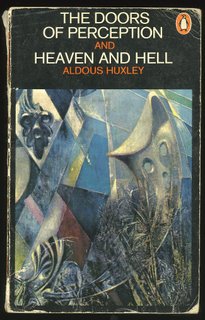
The work set to Maurice Ravel's Piano Trio in A Minor was satisfying to me in many ways. Back in the beginning of the year I had photographed two male dancers who had never danced together before. Edmond Kilpatrick (bottom, left), Ballet BC had as yet no connection to Arts Umbrella up-and-commer Connor Gnam (bottom, right).
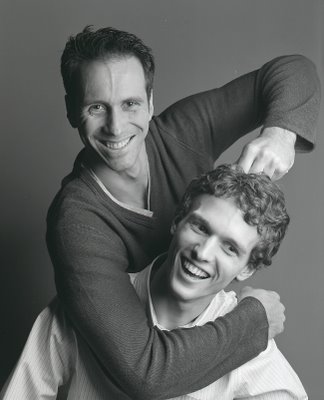
And here they were dancing together and if that weren't enough Gnam's brother James was there too! It was almost impossible not to stare at every move Makaila Wallace made dressed in a wondrous red outfit except every once in a while I had to contrast and compare with Alexis Fletcher. The first the sophisticated prima-ballerina-to-the-max, the second an earthy and innocent young girl who will surely mature to my future delight.
During the second intermission we rant into people who we knew and all would ask about Rebecca's teddy bear which she tightly clutched with one arm. Rebecca kept correcting them that it was not a bear but Lilly the cat.
Elemental Brubeck
Both Rebecca and I have a soft spot in our heart for classy and elegant Jones Henry. His name confuses my dyslexic ways but Rebecca always remembers it as Jones Henry and not as Henry Jones.
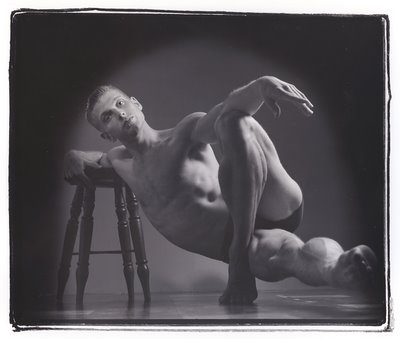
Henry (left) did not disappoint. What did disappoint was choreographer Lar Lubovitch's choice of the wrong Brubeck selection. To me Brubeck (so famous for his quartet) simply did not make my grade as a symphonic composer. Rebecca, who knows her Brubeck, agreed as we thought of the possibilities of:
1. Paul Desmond's song written when he fell for Audrey Hepburn, Audrey.
2. Three to Get Ready or Kathy's Waltz from Time Out.
3. Autumn in Washington Square from Dave Brubeck - Jazz Impressions of New York
4. The Lonesome Road from Gone With the Wind.
5. And of course anything from Rebecca's and my favourite Brubeck Jazz Impression of Eurasia.
For me this was the only work of the evening that did not satisfy as much in spite of Jones Henry.
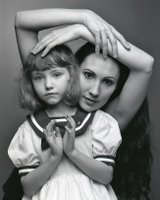

More on that first photograph, top left. I took it in May of 2000 when Ballet BC was saluting the work of its Founding President, Jean Orr. The Georgia Straight was writing about her. I decided I wanted to photograph her with some dancers. At the time my favourites were Emily Molnar (left) and Andrea Hodge ( right, now Ballet Mistress and Rebecca's first ballet teacher, below, left at Arts Umbrella).
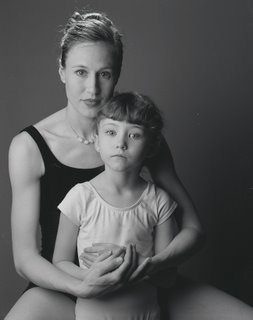
It was Orr with all her past experience who said to me, "We need one more. Let's get Simone Orlando, she is beautiful." I had never noticed Orlando's quiet beauty with that superstar that Emily Molnar was at the time (in all of her 6 ft). But as I posed the four women I knew Orr was right.
Rebecca has followed Orlando's career and I once photographed them together in my studio as seen here. On Friday night I was angry that Rebecca's digital camera had dead batteries and I was not able to photograph her backstage as she chatted at length with Orlando. So yesterday I photographed Rebecca in my studio with Lilly the Cat and wearing the wonderful white dress she wore the previous day. Also in the picture is the $12 little dragonfly necklace that I purchased from Jean Orr. All in all a nice tidy ending to a wonderful weekend.
Simone Orlando
Lauri Stallings
That humanity at large will ever be able to dispense with Artificial Paradise seems very unlikely. Most men and women lead lives at the worst so painful, at the best so monotonous, poor, and limited that the urge to escape, the longing to transcend themselves if only for a few moments, is and has always been one of the principal appetites of the soul. Art and religion, carnivals and saturnalia, dancing and listening to oratory - all have served, in H.G. Wells's phrase, Doors in the Wall.
The Doors of Perception - Aldous Huxley
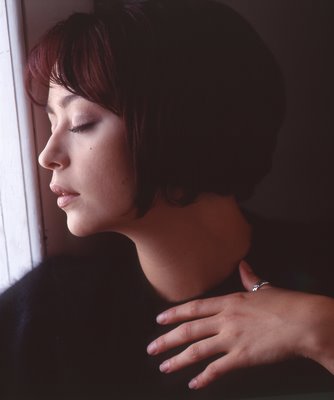
In 1999 the National Post was actively trying to compete and even bury the Globe & Mail. This meant they spent money trying to get original photographs in their paper and specifically in their Saturday paper. I was dispatched by National Post art director Antonio De Luca to photograph Sarah Strange who at the time had a not so big part in Da Vinci's Inquest. When she entered my studio and looked at me directly I was stupified.
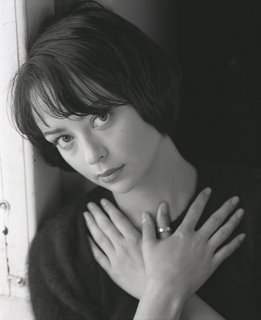
And I can see why so many see her as a starlet or a TV actor. She has a presence that trancends all that but it is a quality that our Flickr, You Tube and review-movies-ad-nauseum society can never understand or appreciate.
The newspapers, even when they may have a week's lead time will dispatch their stringer or city photographer who in a few seconds will take the shots and leave for the next job. Other papers with more interest in profits, than quality, will simply demand that the star, starlet, dancer, actor, director provide their own picture. The result is that you see the same photograph everywhere. In some cases the overworked "art" directors try to crop them to make them look different.
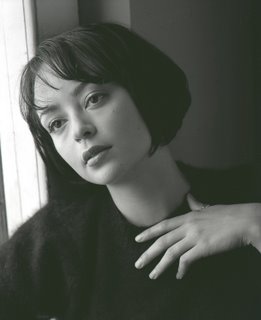
As the use of good lighting is in decline more and more photographs have that Flickr look. And since everybody is shooting like that, a trend is seen, and untrained/computer course art directors or photo editors send photographers and command them to get that look.
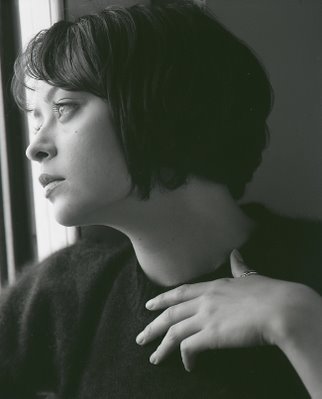
The paradox is that as our ability to understand and appreciate quality imagery (consider the prices that vintage photographs fetch these days) rises, the overall quality of our everyday imagery is in decline.
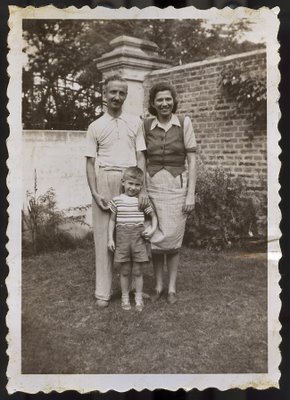
I have often written here how my father was a writer, an expert tango dancer, a graceful swimmer and a very good cook. Of his four talents I can only vouch for the fourth one as we often cooked together. I never saw him swim or dance the tango nor do I ever recall seeing him write or see anything he ever wrote. In fact the only record of his writing that I have is half his signature in his copy of the King James Bible.
The last time I was in Argentina, four years ago, I made it a point to go to the Buenos Aires Herald where he had worked in the 40s and early 50s. I met up with a very sad British expat editor who reminded me of Graham Greene's Charlie Fortnum in his The Honorary Consul. The melancholic editor, smoking Player's (just like my fathe had) told me how he was about to go back "home" after so many years in "BA". He stuck out as a Brit in that Herald newsroom and if he ever sobered up to make it to the airport he would have been branded as a colonial in Britain. The man told me that I could help myself to look at the paper's microfiche library but he warned me that reporters in those days had never uesed a byline. He was right and I found no record and no article that my father might have written. He had simply never existed.
As I look back on my father's life I realize that if I compare his five talents (the extra one was that he could drink) with my own, I can assert I cannot drink, swim gracefully or dance the tango beyond being efficient at it. I can cook fairly well and I have managed to write, like I dance the tango, efficiently.
But I have written lots.
One of the places I have enjoyed writing for is the web-based arts magazine from Montreal Arts & Opinion. I can write about anything I want and I rarely get more than a perfunctory editing. The essays I have written up to now are these 1 2 3 4 5 6
Another is appearing shortly that is an extended variation of this.
But I have another one in the works tentatively called The Dancer where I will collaborate with a very good local modern dancer to produce images where we will attempt to picture her as a string of dance essences.
There is one more think I would like to mention about Arts & Opinion. I share the masthead with a few contributors including:
Noam Chomsky
Pico Iyer
Naomi Klein
Evelyn Lau
I wonder what my father would have thought of that?
More Graham Greene, Sort of.

Last night my wife Rosemary and I went to Kidd Pivot's Lost Action at the Vancouver East Cultural Centre. This was the first time Rosemary has ever seen dance that is not ballet and she was a bit overwhelmed. She is not a veteran as Rebecca is who would not have been fazed in the least by the almost brutal and constant movement of the 7dancers for one hour and twenty minutes.

We noticed among all the people that I know (many from the dance community ready to check out the latest from Kidd Pivot's Crystal Pite, left) Arthur Erickson (83, below) who helped by his driver Ray managed to find himself a seat in the balcony.

When I greeted him after the performance he gesticulated enthusiastically with his hands and said, "Wonderful!"

Because it was opening night there was food served. They had some special corn mufins that packed a bang as they had jalapeño peppers inside. But Rosemary, who noticed all the construction (part of the millions of dollars renovation of the old Methodist church) particularly in what used to be the parking lot (there is a big hole), asked me if the place would remain as it is. I asked Heather Redfern (top left), the present Executive Director who calmed us, "You won't notice anything but the toilets will flush!" This comforted us. The Vancouver Cultural Centre has entertained us, thrilled us, challenged us (just think of Chick Snipper's Slab) all these years.
I particularly remember the Modern Baroque Opera's (please come back!)production of the 120 Songs for the Marquis de Sade which like last night's Lost Action was an ALCAN Award production. This opera had elements of the Pacific Baroque Orchestra playing on the floor next to the performers.

The theatre has no orchestra pit. This meant that not only were we able to see the singers but also musicians. It was a wonderful and intimate combination. "No, we are not going to put an orchestra pit," Redfern said to us. I did not raise the issue with Redfern as to how it felt being on the front row with a naked Marquis de Sade (Michael Douglas Jones with Christine Duncan as the Countess) swinging it back and forth not four ft away.

The second person I ever photographed inside the VECC (I photographed the first Executive Director Chris Wooten sometime in 1978, inside and outside as seen here) was a broadcaster who had just arrived to Vancouver via her old home in England. Her name was Vicki Gabereau.

Something very special about the VECC is that they are perhaps the only cultural institution (besides the Firehall Theatre) that features and caters to dance, theatre, music and the visual arts regularly. The lobby always has some sort of show of paintings or sculpture. I have heard many concerts of new music. It was here that I discovered the virtuosity of jazz man Brad Turner who in an avant-garde piece played his trumpet (accompanied by a percussionist) for almost 6 minutes without ever really playing a note. He made noises with the valves, etc while hiding his face with a brimmed hat.

I was in 2001 that the VECC started a tradition. The Electric Company Theatre's Dona Flor's And Her Two Husbands premiered with Carmen Aguirre, the extremly funny faux basoonist Don Adams and actor Ty Olsson who in all his time on stage (most of the time) wore absolutely nothing and dangled. Halfway through the production Aguirre made it equal time and shed her clothes.

True to this tradition, VECC features full nudity or partial nudity at least once a year. To this day when I cite Chick Snipper's Slab (2003)in the presence of Rebecca (she was 6 then) she says, "They wore nothing." In the photo below that's Kathleen McDonagh, Ann Cooper center back and Susan Elliott, centre.
As we went home last night I thought that Vancouver without the VECC would be a very poor place. And thanks to the VECC's existence it is that much better. I then caught another VECC memory, those four microphones decorated with pink ribbon. Does anybody remember?
Malcolm Lowry, Michael Turner & Tony Ricci All Drank At The NBI
Tuesday, November 27, 2007
The only two things that people remember about Vancouver is that Malcolm Lowry lived and Errol Flynn died here.
John Lekich

The most important change that Expo 86 brought to Vancouver was a more realistic liquor law. Prior to Expo 86, La Bodega on Howe was the only restaurant where you could stare at a salad all day and drink yourself to oblivion, even on a Sunday. For years I had watched people get drunk on coffee at the Classical Joint on Carral Street. It took me a while to figure out that patrons would whisper, when asked what they wanted, "A dark coffee." This concoction people said had Irish whiskey. Before Expo 86, Tony Ricci was sitting pretty with his Marble Arch Hotel. It had a liquor license that had the latest closing hours in Vancouver (2 am). Those who would fortify their evenings with High Test at the Smilin' Buddha on East Hastings and ejected by bouncer Igor at 1 am, would run to the Arch for more.
In 1995 the exotic dancer bar craze of Vancouver was beginning to wane. But again, Ricci was sitting pretty as the unsigned owner of the NBI (the North Burnaby Inn) on East Hastings. It had the largest and best liquor and off sale license East of Boundary. It had a huge room with a stage where the city's best strippers performed. It was the only strip bar in Burnaby (besides the Lougheed Motel on Willingdon). The NBI was doing just fine. But there was another room, sort of like a pub, that never had customers except terminal city alcoholics.
This is when a man who does not profiit from selling New York landmarks because he lives in Vancouver, poet Michael Turner, went up to Ricci and suggested that the room be converted to a Mecca for poetry.

He thought that it should be called the Malcolm Lowry Room. And so it was. Malcolm Lowry Room opened its doors, prominently decorated with a beautifully framed portrait of Lowry by his shack on Cates Park on the other side of Burrard Inlet near Deep Cove. Turner then (I am almost sure) started rumours that Lowry (reported to be a fine swimmer) had braved the waters of Burrard Inlet, desperate for gin or two at the bar that was in the exact same spot where the NBI was.
At about that time writer John Lekich, no worse than Turner in his ability to persuade, pitched the story of the Malcolm Lowry Room to editor Charles Campbell at the Georgia Straight. I was dispatched to take the pictures and told it was a cover story.
I rounded up my equipment, and before I left, I went to my book shelves in search of my Book-of-the-Month Club copy of Lowry's Under the Volcano. After taking my portrait of Ricci (barmaid behind him), Michael Turner (with the framed photograph of Lowry) I used the book for the cover shot involving Turner and a barmaid. We picked one who was not as well endowed as most of the others who worked there. We didn't want the picture to be rejected by the Straight which was beefing up its moral standards.

Before I left I went up to Ricci and told him, "Tony, here is Malcolm Lowry's famous novel. Keep it under the bar in case anybody asks." His reply was his usual one, "Alex, I owe you big." And he always meant that.
Don't Tell A Woman What To Wear
Monday, November 26, 2007

If you happen to see yesterday's blog you might note the picture of rebecca that I repeat here (left). It almost didn't happen.
On Friday afternoon I asked Rosemary to call Hilary to ask Rebecca to wear black for our Ballet BC date that evening. She was to tell Hilary that I was dressing in black. When Rebecca goes to her Wednesday ballet class she wears a black leotard, a little dark purple (almost black) short skirt, a black top and she wears her hair up. I love her like that and that was what I wanted her to wear. That was not to be.
When I picked her up she was wearing a new dress given to her by her Nana (her other grandmother). Holding on to Lilly the cat she looked lovely. Because her digital camera was not working I was not able to take her picture with Simone Orlando back stage after the ballet. I decided I was going to photograph her in my studio the next day.

When a photographer uses more than one speed film at the same time, mistakes happen. I shot a roll (above) using the beautiful capabilities of the now discontinued Kodak Technical Pan in 120 which has a speed of 25 ISO. After I exposed the 10 shots (that's a complete roll with my Mamiya RB) I noticed that the roll was not Technical Pan but my usual Plus-X Pan with an ISO of 100. This meant that I had overexposed it by two stops. I took some pictures again with Technical Pan and tried to repeat the same poses. After that I shot a second roll of Plus-X (correctly exposed) of Rebecca doing other poses with Lilly and without.

I worsened the problem by putting all three rolls into my bag so that when I realized what I had done I could not tell which was the bad roll. Last night I played it safe and processed one roll of Plus-X. It was perfectly exposed. This meant that the second one was the one.
That roll I underdeveloped with a much diluted developer (HC-110) and the results were excellent, that's the second picture above.
Taking photographs of Rebecca, who is a veteran, is a pleasure. She must be older than her age when she asked me if she had beautiful feet. I had indicated to her to take off her shoes for the full-length shots. I told her that yes, and that both my mother and I had beautiful feet and that she had inherited from us.

I was charmed when she talked to Lilly, "I want some pictures without you so I hope you don't mind." Rebecca put Lilly on a table and posed for me. And from now on I will not tell Rebecca what to wear. I will let her surprise me.
Aldous Huxley, Simone Orlando & Lilly The Cat
Sunday, November 25, 2007
But the man who comes back through the Door in the Wall will never be quite the same man who went out. He will be wiser but less cocksure, happier but less self-satisfied, humbler in acknowledging his ignorance yet better equipped to understand the relationship of words to things, of systematic reasoning to the unfathomable Mystery which it tries, forever vainly to comprehend.
The Doors of Perception - Aldous Huxley

Friday Night Rebecca and I attended a performance of Ballet BC called Elemental Brubeck An Evening With Jazz. It featured three works. The first was Serge Bennathan's In and Around Kozla Street, the second was a premiere of Simon Orlando's Realm of Her Eclipse. The third was Lar Luvobitch's Elemental Brubeck.
In and Around Kozla Street
I am unable to see this sad piece without thinking of two other previous performances, years back, by Ballet BC. One featured Crystal Pite and her beau Jay Gower Taylor. This is when I first noticed (hard not to!)an embrace where the couple kiss and keep dancing. I didn't time it then but it felt like two minutes. The second occasion, January 22, 1988, was my favourite as it featured red haird Lauri Stallings and the most electryfing man that ever danced for Ballet BC, Mirsoslav Zydowicz (below brushing artist Tiko Kerr).


As I watched Lauri Stallings and Mirsoslav Zydowicz twirl around and around - their lips seemingly glued together - I asked Rosemary how long she thought the kiss was and, I had a revelation, which I whispered to my wife Rosemary: "Ballet is about sex." She hushed me, pointing out that Stallings' boyfriend, Rick Carvlin, was sitting next to us. He had heard me. "They kiss for one minute and 58 seconds," he said. "I have timed them before." Lauri Stallings more so because of her red hair and a very prsonal style imposed a fiery passion.

Crystal Pite (left) had been more ethereal, more tender.
Friday evening's was different too. Alexis Fletcher (bottom, right, alumni of Arts Umbrella) danced with James Gnam. Because of Fletcher's youth it felt like a first time kiss.

It was wonderful to watch. And it was wonderful to watch (Rebecca commented on how she liked her) this dancer, who in spite of Makaila Wallace's performance that evening as the lead in Orlando's ballet, has to be the dancer to watch in Ballet BC.
At the intermission Rebecca wandered to a small table where ballet paraphernalia was being sold. I spotted Ballet BC Founding President Jean Orr (universally adored). She always greets me with her smile and I always want to embrace and kiss her. This I did. Meanwhile Rebecca asked if I would buy her a necklace. I said no. Orr looked at me and I had to change my mind. I asked Orr, "How long was it? (without having to explain anything.)" She answered, "It felt like a two-minute one."
Realm of Her Eclipse
When I first saw the sets designed and painted by Charles Forsberg, and the way dancers quickly appeared and disappeared by what seemed to be moving doors I thought of a book I had read in my not too psychedelic youth. I saw in my head the cover (even though Max Ernst's Cocktail Drinker does not resemble Forsberg's sets) of Aldous Huxley's The Doors of Perception and Heaven and Hell.

The work set to Maurice Ravel's Piano Trio in A Minor was satisfying to me in many ways. Back in the beginning of the year I had photographed two male dancers who had never danced together before. Edmond Kilpatrick (bottom, left), Ballet BC had as yet no connection to Arts Umbrella up-and-commer Connor Gnam (bottom, right).

And here they were dancing together and if that weren't enough Gnam's brother James was there too! It was almost impossible not to stare at every move Makaila Wallace made dressed in a wondrous red outfit except every once in a while I had to contrast and compare with Alexis Fletcher. The first the sophisticated prima-ballerina-to-the-max, the second an earthy and innocent young girl who will surely mature to my future delight.
During the second intermission we rant into people who we knew and all would ask about Rebecca's teddy bear which she tightly clutched with one arm. Rebecca kept correcting them that it was not a bear but Lilly the cat.
Elemental Brubeck
Both Rebecca and I have a soft spot in our heart for classy and elegant Jones Henry. His name confuses my dyslexic ways but Rebecca always remembers it as Jones Henry and not as Henry Jones.

Henry (left) did not disappoint. What did disappoint was choreographer Lar Lubovitch's choice of the wrong Brubeck selection. To me Brubeck (so famous for his quartet) simply did not make my grade as a symphonic composer. Rebecca, who knows her Brubeck, agreed as we thought of the possibilities of:
1. Paul Desmond's song written when he fell for Audrey Hepburn, Audrey.
2. Three to Get Ready or Kathy's Waltz from Time Out.
3. Autumn in Washington Square from Dave Brubeck - Jazz Impressions of New York
4. The Lonesome Road from Gone With the Wind.
5. And of course anything from Rebecca's and my favourite Brubeck Jazz Impression of Eurasia.
For me this was the only work of the evening that did not satisfy as much in spite of Jones Henry.


More on that first photograph, top left. I took it in May of 2000 when Ballet BC was saluting the work of its Founding President, Jean Orr. The Georgia Straight was writing about her. I decided I wanted to photograph her with some dancers. At the time my favourites were Emily Molnar (left) and Andrea Hodge ( right, now Ballet Mistress and Rebecca's first ballet teacher, below, left at Arts Umbrella).

It was Orr with all her past experience who said to me, "We need one more. Let's get Simone Orlando, she is beautiful." I had never noticed Orlando's quiet beauty with that superstar that Emily Molnar was at the time (in all of her 6 ft). But as I posed the four women I knew Orr was right.
Rebecca has followed Orlando's career and I once photographed them together in my studio as seen here. On Friday night I was angry that Rebecca's digital camera had dead batteries and I was not able to photograph her backstage as she chatted at length with Orlando. So yesterday I photographed Rebecca in my studio with Lilly the Cat and wearing the wonderful white dress she wore the previous day. Also in the picture is the $12 little dragonfly necklace that I purchased from Jean Orr. All in all a nice tidy ending to a wonderful weekend.
Simone Orlando
Lauri Stallings
That humanity at large will ever be able to dispense with Artificial Paradise seems very unlikely. Most men and women lead lives at the worst so painful, at the best so monotonous, poor, and limited that the urge to escape, the longing to transcend themselves if only for a few moments, is and has always been one of the principal appetites of the soul. Art and religion, carnivals and saturnalia, dancing and listening to oratory - all have served, in H.G. Wells's phrase, Doors in the Wall.
The Doors of Perception - Aldous Huxley
Sarah Strange Starlet - Not
Saturday, November 24, 2007

In 1999 the National Post was actively trying to compete and even bury the Globe & Mail. This meant they spent money trying to get original photographs in their paper and specifically in their Saturday paper. I was dispatched by National Post art director Antonio De Luca to photograph Sarah Strange who at the time had a not so big part in Da Vinci's Inquest. When she entered my studio and looked at me directly I was stupified.

And I can see why so many see her as a starlet or a TV actor. She has a presence that trancends all that but it is a quality that our Flickr, You Tube and review-movies-ad-nauseum society can never understand or appreciate.
The newspapers, even when they may have a week's lead time will dispatch their stringer or city photographer who in a few seconds will take the shots and leave for the next job. Other papers with more interest in profits, than quality, will simply demand that the star, starlet, dancer, actor, director provide their own picture. The result is that you see the same photograph everywhere. In some cases the overworked "art" directors try to crop them to make them look different.

As the use of good lighting is in decline more and more photographs have that Flickr look. And since everybody is shooting like that, a trend is seen, and untrained/computer course art directors or photo editors send photographers and command them to get that look.

The paradox is that as our ability to understand and appreciate quality imagery (consider the prices that vintage photographs fetch these days) rises, the overall quality of our everyday imagery is in decline.
Noam Chomsky, Naomi Klein, Pico Iyer & Me
Friday, November 23, 2007

I have often written here how my father was a writer, an expert tango dancer, a graceful swimmer and a very good cook. Of his four talents I can only vouch for the fourth one as we often cooked together. I never saw him swim or dance the tango nor do I ever recall seeing him write or see anything he ever wrote. In fact the only record of his writing that I have is half his signature in his copy of the King James Bible.
The last time I was in Argentina, four years ago, I made it a point to go to the Buenos Aires Herald where he had worked in the 40s and early 50s. I met up with a very sad British expat editor who reminded me of Graham Greene's Charlie Fortnum in his The Honorary Consul. The melancholic editor, smoking Player's (just like my fathe had) told me how he was about to go back "home" after so many years in "BA". He stuck out as a Brit in that Herald newsroom and if he ever sobered up to make it to the airport he would have been branded as a colonial in Britain. The man told me that I could help myself to look at the paper's microfiche library but he warned me that reporters in those days had never uesed a byline. He was right and I found no record and no article that my father might have written. He had simply never existed.
As I look back on my father's life I realize that if I compare his five talents (the extra one was that he could drink) with my own, I can assert I cannot drink, swim gracefully or dance the tango beyond being efficient at it. I can cook fairly well and I have managed to write, like I dance the tango, efficiently.
But I have written lots.
One of the places I have enjoyed writing for is the web-based arts magazine from Montreal Arts & Opinion. I can write about anything I want and I rarely get more than a perfunctory editing. The essays I have written up to now are these 1 2 3 4 5 6
Another is appearing shortly that is an extended variation of this.
But I have another one in the works tentatively called The Dancer where I will collaborate with a very good local modern dancer to produce images where we will attempt to picture her as a string of dance essences.
There is one more think I would like to mention about Arts & Opinion. I share the masthead with a few contributors including:
Noam Chomsky
Pico Iyer
Naomi Klein
Evelyn Lau
I wonder what my father would have thought of that?
More Graham Greene, Sort of.
Thursday, November 22, 2007
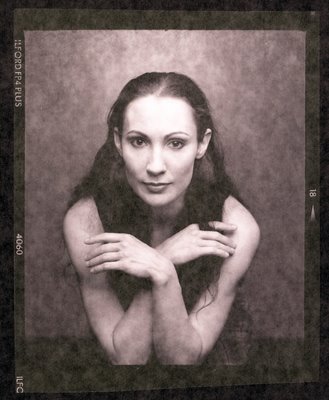
Tomorrow evening Rebecca (dressed to the teeth) and I will be ensconced in our seats at the Queen Elizabeth Theatre watching every move that Simone Orlando makes. For Rebecca and for this cynical old timer, Orlando is a super star. She is a super star of elegant movement. Both Rebecca and I will be doubly enjoying the prospect of seeing Orlando while listening to our very favourite Dave Brubeck in choreographer Lar Lubovitch's Elemental Brubeck. Of late Rebecca has been requesting I play Dave Brubeck's Jazz Impressions of Eurasia on her Saturday visits to our house. I am pleased. After all I first heard the Dave Brubeck Quartet play in Austin in 1958 and as soon as they released Time Out in 1959I had purchased the record. While some may have heard of its sequel, Time Further Out few might know that there is another (and in my collection) Time In Outer Space!
Rebecca is intrigued by Brubeck's experiments and adventures in odd time signatures. My favourite has always been 5/4 time. With Rebecca we have been experimenting with this beat. She is even teaching Lauren in their Saturday afternoon sock hops in our long living room floor.
Tomorrow night not only will we enjoy, Simone Orlando, Ballet BC and Brubeck but we will certainly not miss the opportunity to visit this superstar of grace back stage. I wonder why other little girls don't do this?

It is not always that I know without doubt where I was when something happened so many years ago. But the banner in this picture says April 10, 1980. At the time I had a very nice contract to take PR photographs for Canadian Pacific Limited so I photographed trains, trucks, transports, etc. I also had an equivalent situation with Air Canada for the same sort of thing and PR manager Harry Atterton dispatched me to Boeing in Seattle to photograph the 1600th Boeing 727 which happened to be the last Air Canada purchased. In all Boeing made 1832 of these airplanes but kept the last one for its museum. I remember making a PR boo-boo by asking the pilot to kick the tire. As soon as I said it and he looked at me sternly I realized what I had done.
In 1979, it was during the rainy season and I was in a humid and hot Palenque in the state of Chiapas. I had been chain smoking Veracruzan Flor de la Costa cigars all day to ward off the mosquitos. I felt like a miniature version of Indiana Jones as Palenque in those years was a hard to get to Mayan ruin. I was pretty well alone in the ruins and I could go anywhere and snap pictures to my heart's content. That night spend it in a nearby cheap hotel and asked the man at the front desk to wake me up early as I had to catch a early plane in the Villahermosa airport. This involved first catching a third class bus on the road outside the hotel. The man at the desk told me he had no clock so he could not really wake me up. I realized I was going to have to depend on my alarm wrist watch. I did not sleep.
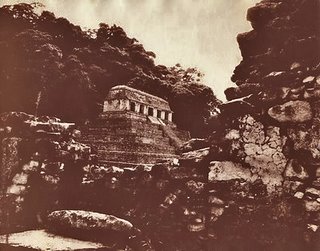
I almost died with stress as the bus to the airport seemed to stop everywhere for peasants getting on with turkeys and chickens. The bus had many forward gears. Every time it stopped it took forerver for it to reach its very slow cruising speed.
But I managed to get to the airport just in time. On the tarmac there was this all-white Mexicana Boeing 727. I was sweaty and tired but the pristine appearance of the airplane invigorated me. That plane felt like civilization. It felt like home.

Anybody who has ever flown in a 727 will know the thrill of taking off and landing in an airplane that has three engines in its tail-end. The 727 needs a high angle of attack. This means that for a neophyte like me it feels like the airplane is taking off almost in a vertical position. There is nothing like taking off in a 727. Even though the 727 was the first jet airplane considered quiet enough to use LaGuardia Airport in New York City, June 1, 1964 the take off noise and the almost vertical position combined to making it for me the most exciting airplane I have ever flown in.
Harry Atterton had told me that the 727 was the first ever airplane to have been awarded a gold medal for valour. I checked on this and sure enough in 1972 Morocco's King Hassan II awarded the 727 a medal of honour for surviving a fighter strafing attack. And for more info on the 727 look here. I can understand why the 727 is considered the most successful commercial airliner of all time.
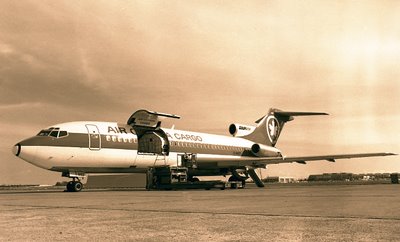
When I spot a 727 in some airport (usually a FedEx cargo version) I look at it longingly as I sit comfortably in what really is a flying bus. The thrill of flying has faded away for me. I can only feel glad that I have the memory of those vertical takeoffs - thrilling yet comforting. I was home.
More
And More
Flying without flying
Death by Powerpoint and Constellations
Addendum: My Texan friend Howard Houston flew a Boeing KC-135 tanker over Vietnam and he had this to say of the 727's steep climb.
Alex;
I am sure that I flew in a 727 once or twice, commercially, a long time ago. I don't think that the USAF had any in their inventory when I flew for them. I do seem to recall the steep climbout, although I think that was a capability rather than a requirement.
H.H.

Tomorrow evening Rebecca (dressed to the teeth) and I will be ensconced in our seats at the Queen Elizabeth Theatre watching every move that Simone Orlando makes. For Rebecca and for this cynical old timer, Orlando is a super star. She is a super star of elegant movement. Both Rebecca and I will be doubly enjoying the prospect of seeing Orlando while listening to our very favourite Dave Brubeck in choreographer Lar Lubovitch's Elemental Brubeck. Of late Rebecca has been requesting I play Dave Brubeck's Jazz Impressions of Eurasia on her Saturday visits to our house. I am pleased. After all I first heard the Dave Brubeck Quartet play in Austin in 1958 and as soon as they released Time Out in 1959I had purchased the record. While some may have heard of its sequel, Time Further Out few might know that there is another (and in my collection) Time In Outer Space!
Rebecca is intrigued by Brubeck's experiments and adventures in odd time signatures. My favourite has always been 5/4 time. With Rebecca we have been experimenting with this beat. She is even teaching Lauren in their Saturday afternoon sock hops in our long living room floor.
Tomorrow night not only will we enjoy, Simone Orlando, Ballet BC and Brubeck but we will certainly not miss the opportunity to visit this superstar of grace back stage. I wonder why other little girls don't do this?
The Boeing 727, Home - Straight Up
Wednesday, November 21, 2007

It is not always that I know without doubt where I was when something happened so many years ago. But the banner in this picture says April 10, 1980. At the time I had a very nice contract to take PR photographs for Canadian Pacific Limited so I photographed trains, trucks, transports, etc. I also had an equivalent situation with Air Canada for the same sort of thing and PR manager Harry Atterton dispatched me to Boeing in Seattle to photograph the 1600th Boeing 727 which happened to be the last Air Canada purchased. In all Boeing made 1832 of these airplanes but kept the last one for its museum. I remember making a PR boo-boo by asking the pilot to kick the tire. As soon as I said it and he looked at me sternly I realized what I had done.
In 1979, it was during the rainy season and I was in a humid and hot Palenque in the state of Chiapas. I had been chain smoking Veracruzan Flor de la Costa cigars all day to ward off the mosquitos. I felt like a miniature version of Indiana Jones as Palenque in those years was a hard to get to Mayan ruin. I was pretty well alone in the ruins and I could go anywhere and snap pictures to my heart's content. That night spend it in a nearby cheap hotel and asked the man at the front desk to wake me up early as I had to catch a early plane in the Villahermosa airport. This involved first catching a third class bus on the road outside the hotel. The man at the desk told me he had no clock so he could not really wake me up. I realized I was going to have to depend on my alarm wrist watch. I did not sleep.

I almost died with stress as the bus to the airport seemed to stop everywhere for peasants getting on with turkeys and chickens. The bus had many forward gears. Every time it stopped it took forerver for it to reach its very slow cruising speed.
But I managed to get to the airport just in time. On the tarmac there was this all-white Mexicana Boeing 727. I was sweaty and tired but the pristine appearance of the airplane invigorated me. That plane felt like civilization. It felt like home.

Anybody who has ever flown in a 727 will know the thrill of taking off and landing in an airplane that has three engines in its tail-end. The 727 needs a high angle of attack. This means that for a neophyte like me it feels like the airplane is taking off almost in a vertical position. There is nothing like taking off in a 727. Even though the 727 was the first jet airplane considered quiet enough to use LaGuardia Airport in New York City, June 1, 1964 the take off noise and the almost vertical position combined to making it for me the most exciting airplane I have ever flown in.
Harry Atterton had told me that the 727 was the first ever airplane to have been awarded a gold medal for valour. I checked on this and sure enough in 1972 Morocco's King Hassan II awarded the 727 a medal of honour for surviving a fighter strafing attack. And for more info on the 727 look here. I can understand why the 727 is considered the most successful commercial airliner of all time.

When I spot a 727 in some airport (usually a FedEx cargo version) I look at it longingly as I sit comfortably in what really is a flying bus. The thrill of flying has faded away for me. I can only feel glad that I have the memory of those vertical takeoffs - thrilling yet comforting. I was home.
More
And More
Flying without flying
Death by Powerpoint and Constellations
Addendum: My Texan friend Howard Houston flew a Boeing KC-135 tanker over Vietnam and he had this to say of the 727's steep climb.
Alex;
I am sure that I flew in a 727 once or twice, commercially, a long time ago. I don't think that the USAF had any in their inventory when I flew for them. I do seem to recall the steep climbout, although I think that was a capability rather than a requirement.
H.H.
Tuesday, November 20, 2007
Any sufficiently advanced technology is indistinguishable from magic.
Arthur C. Clarke
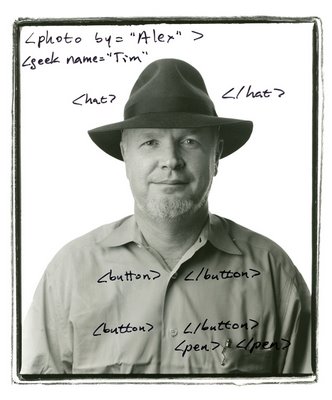
When I told an intelligent friend that I was researching Tim Bray, the Distinguished Engineer and Director of Web Technologies at Sun Microsystems, publisher of a popular weblog, ongoing, and co-chair of the IETF AtomPub Working Group, he countered:
“I’ve listened to an on-line interview of Bray done by another geek - lots of acronyms. It’s like they are speaking another language. Sort of like Portuguese might sound to a Spaniard. I can’t understand it. The best I can do is figure out they are talking about computer languages and systems. Your argument will be in the line of 'Tim Bray is a modern day deus ex machina. He makes things happen and no one (or almost no one) knows why.'”
My friend is right. After failing to understand the first chapter of Learning XML, by Erik T. Ray, even after repeated attempts, I concluded that computer programming is no different in complexity from a mason’s know-how for building a Gothic cathedral. While Bray pioneered search engines in the 90s, besides being the principal innovator of XML (extended markup language), he told me recently at my studio, “I haven’t done any work on XML in a few years. The other things I work on are important and interesting, too. Chances are, XML will lead my obituary.”
Tim Bray, who lives in Vancouver, defined XML for me in one sentence, “It is a method for packing up electronic data and documents so that having been packed up on one computer anywhere in the world, they can be reliably unpacked on any other computer (running any combination of software and hardware) anywhere else in the world, then or many years later, and used for whatever purpose desired, without regard to the originator’s intent.”
His answer to the question of what he did was clearer, “I help Sun by being aware of what the people who build the internet are thinking and doing (I have to help build the internet to do this.), and ensuring that those people and Sun know about each other.”
Through Wikipedia I found out that markup language is just a computer specific language, much more complex but no less useful that the original markups on handwritten or typed manuscripts by editors, and line editors for books and magazines.
XML, and most of Bray’s accomplishments, began after he went for a double major in mathematics and computer science at the University of Guelph in 1981. Bray added computer science when he realized that math teachers weren’t being hired. “In math I had worked like a dog to get Cs and all of a sudden I was getting As in the computer courses. God was reaching behind my shoulder; telling me, ‘Kiddo, this is what you ought to be doing.’ And I did.”
Bray’s road to Damascus experience happened while working at the University of Waterloo (1989-1990) with the Oxford University Press, computerizing the second edition of the OED. “We had a specially constructed search engine. In an early web publishing conference in 1994 one of the speakers stood up and said, ‘Search is going to be a good application for the new web “thing”.’ He set a bomb in my head. All of a sudden I could see how to build a web search engine. I went to live in Yaletown and worked on the engine for 6 months (I ate and drank beer at the Yaletown Brewing Company downstairs. I started the Open Text Corporation and Open Text, was a commercialized and early search engine based on the high-performance engine we employed in the OED project. We were (1995) one of the top ones and partnered with Yahoo. The way search engines are now was invented by many people inserting little contributions and Google put in the big one of link counting to rankings. I think I was the first person to number the results, 1. 2. 3….. There are little bits of everybody’s handiwork in there.”
Bray, who studied the cello for 20 years, is urbane and well read. He is a populist of sorts. He has a smile on his face when he talks about the web and especially about Wikipedia. Bray does not agree with the opinions of Silicon Valley insider Andrew Keen who in his recent book The Cult of the Amateur – How Today’s Internet is Killing Our Culture has this to say about Wikipedia,
“Wikipedia has become the third most visited site for information and current events; a more trusted source for news than the CNN or the BBC web sites, even though Wikipedia has no reporters, no editorial staff and no experience in newsgathering. It’s the blind leading the blind – infinite monkeys providing infinite information for infinite readers, perpetuating the cycle of misinformation and ignorance.”
Bray sees it differently. “By and large Wikipedia results are quite good and when errors creep in they tend to be self correcting on a fairly quick basis. There are errors in Wikipedia and there are errors in the Britannica, the difference is that the errors in Wikipedia get fixed. The reason it works well is that there is a community of engaged people who have found they have a passion for being amateur encyclopedists. It is a good thing because it should teach the really important lesson that you cannot believe what you read. If Wikipedia says something that is true, that is indicative, it’s not definitive. You need to look at the primary sources, but Wikipedia will take you there.”
After reading in the December New York Times Magazine the story Rewiring the Spy by Clive Thompson on how the American intelligence agencies are banding together with a proprietary weblog and wiki I asked Bray why he often goes to Washington DC. He said, “I have done a lot of work for the intelligence community, principally for the NSA (National Security Agency). I am a search expert. The NSA is a distinctly odd place. I love it. If I were to start my career again I just might well plunge headlong into intelligence.”
In trying to figure out the smiling man with the hat I remember that Bray once told me this, “I’m kind of an open book, my soul is there to read in my blog”
----------------------------------------------------------------------------------------------------------------------------------
Addendum
The above piece appeared originally here in the Georgia Straight in their third person style. The editors gave it the header Father of XML - Uncle of Search Engines. Mr. Tim Bray would like to clarify what he thinks is an error:
I'm really uncomfortable with the term "Father of XML". In fact, there were two other people whose contributions were larger. I'm happy with "co-inventor" or "promoter" or a bunch of other things.
Tim Bray
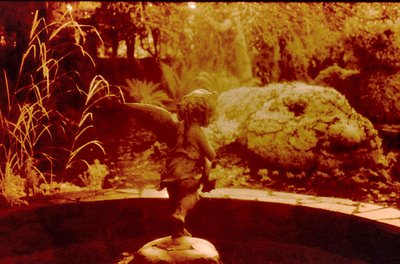
Yesterday Rosemary and I strolled in VanDusen Botanical Garden during the sunny afternoon. I had a half-used roll of Kodak b+w infrared film in my Nikon FM. The pictures you see here I took with the 35mm wide angle lens and a deep red, No 25 filter. The colour tint effect is the result of scanning the negatives while telling the Epson V700 that they are colour negatives.
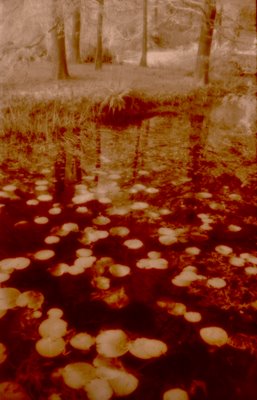
We usually like to do this walking with Rebecca and Lauren, but on Sundays they are with their other grandmother. Rebecca and Lauren have the garden memorized and they have their favourite plants, trees and places. Lauren likes to say, "Let's get lost in the maze." We have problems steering Rebecca away from the plush toys in the VanDusen shop. The girls like to smell the fragrant magnolias. More often than not I have to pick them up to do this as the Vandusen magnolias (the fragrant ones) like to flower on the tops.
Like the under used and under appreciated cultural events of Vancouver, this smack in-the-centre-of-the-city botanical garden is really an undiscovered gem. Even on rainy days it is a delight to walk with an umbrella. In mid November it is particularly nice to see the dried up but still standing miscanthus and other ornamental grasses. The hollies in the holly garden have their berries and those living fossils, the dawn cypresses (Metasequoia glyptostroboides ) have bright red needles before these decidious conifers shed them.
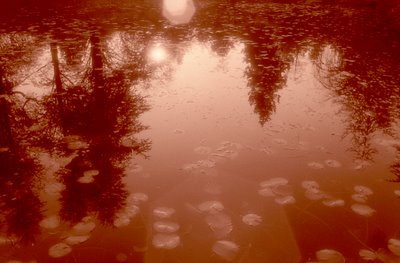
There are many parts of the garden where you cannot see any city buildings or hear any of the cars on nearby Oak Street. You could be in the middle of a carefully manicured wilderness.
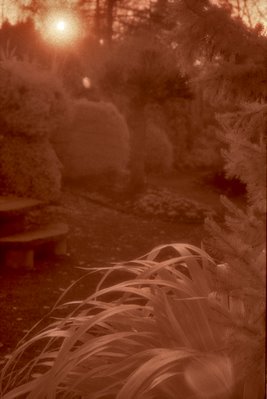
Except, of course, that the sporadic whine of ambulances on their way to the children's hospital jostles one into an awareness that winter, death and decay not only affects gardens. A quick retreat home and a large mug of strong tea usually helps me to suppress all that!
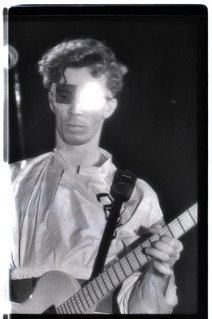
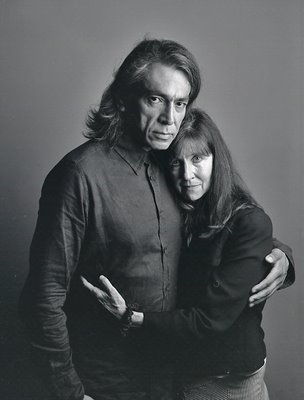
Last year I first saw Byron Chief-Moon dance with the Karen Jamieson Dance Company. I photographed him with Karen Jamieson in my studio for a one page profile for VLM Magazine. Of Chief-Moon I wrote:
He is of the Blackfoot Confederacy. "I am not a chief, " he told me, "That was my mother's name." I started dancing at age 2. "Space is a special connection to landscape. Even when I work in my studio I am in the landscape in spirit."
Yesterday afternoon Rebecca, Lauren (5) and I went to the Scotia Dance Centre for a performance of Rosario Ancer's Flamenco Rosario, Jay Hirabayashi's Kokoro Dance and Byron Chief-Moon's Coyote Percussive Performing Arts.
Rosario Ancer had an interesting flamenco crossover, while staying true to her own art. She had both Jay Hirabayashi and Barbara Bourget contributing their butoh with Ancer herself dressed as a raven in a flamenco interpretaion of the meaning of that bird in ancestor stories of the Western Canadian Native Peoples. Listening to Antonio de Jerez sing his soleá while seeing Ancer's raven was disturbing and satisfying at the same time. While Lauren had never seen butoh before she did not squirm in her seat. She calmly watched the 6 female Kokoro dancers do their excercise in apparent slow motion.
In an after performance talk I finally saw the light on at least one aspect of butoh when Hirabayashi explained the butoh concept of time. A dancer's slow movement to the eye of the bystander is plenty quick in the head of the dancer. Butoh challenges our perception of time in much the same way as Einstein's relativistic clock on moving trains. And to top it all, dancer Caroline Farquhar gave Rebecca, Lauren and me a quick lesson in butoh butterfly eyes!
But it was the solo performance of Byron Chief-Moon in Blood Alley that had Rebecca and I nodding at each other with a smile on our face. A smile on our face, in spite of a bleak prognosis on the state of man, at least as seen by Byron Chief-Moon in his interpretation of an urban aboriginal who has lost his way. He began as man/ape learning to walk, to dance, to dream and then to forget. And when the addiction set in, it was heart wrenching to see Byron Chief-Moon do a drunken interpretation of what I would call the common Indian stomp. His second piece, a projected colour video called Butte, cheered us up as Byron Chief-Moon danced in it and became one with the beautiful landscape of Southern Alberta.
Driving home I thought of other occasions where I was as affected. It began with sound.
Sound in all its glory first entered my consciousness in 1951 or 1952 when my grandmother Lolita took me to see Randolph Scott in Colt 45.
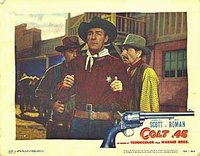
Scott plays a Colt 45 salesman and it is the sound of the gun, as it echoed (effective even before stereo and surround sound) in the movie theatre on Lavalle Street that woke me up to the wonders of pure sound. I remember seeing DEVO at the Commodore in 1979 and hearing the pure, loud sounds of new wave guitars. The sound was primal in the same way as ten years later when I heard J.J. Johnson play his trombone at the Vancouver Playhouse. During a solo, he stopped and said, "The acoustics here are very good," and he bypassed the microphone. The sound was much as the sound of those DEVO guitars. It was a piercing sound that beckoned me to some past that may have been in my genes if not in my memory. That sound again appeared for me when John Eliot Gardiner played for us a modern violin and then a baroque violin.
I cannot explain except that Byron Chief-Moon's dance went through my eyes and into my brain directly and as quickly as Keen's Mustard or those sounds of DEVO, J.J. Johnson's trombone, Randolph Scott's Colt 45 and John Eliot Gardiner's baroque violin.
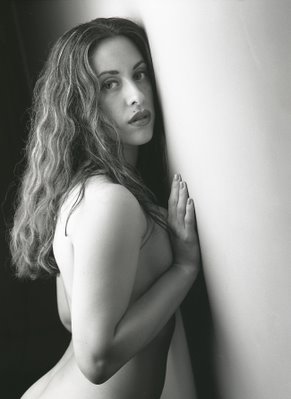
Sometimes the excuse for running photographs of a beautiful woman can be a feeble one. Do I need content? Every once in a while when I go through my files and spot Argentine Linda Lorenzo's very thick folder with almost two year's worth of photographs I marvel at how few of them have seen the light of day. Some appeared in a show Juan Manuel Sanchez, Nora Patrich and I had at the long gone gallery, the Simon Patrich Gallery on Granville.
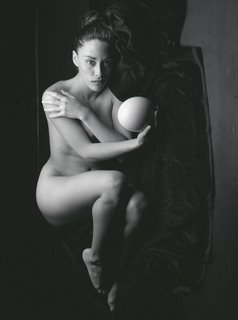
The show was called Nostalgia and the three of us worked on the beautiful and pliable Linda Lorenzo and coverted her into all our sweet añoranzas or longings from our place of birth. We managed to put her into radio programs of our youth. We worked on a series of Argentine birds and we even made Lorenzo up to almost look like Eva Perón. Here are an almost random pick from the first few folders I found.
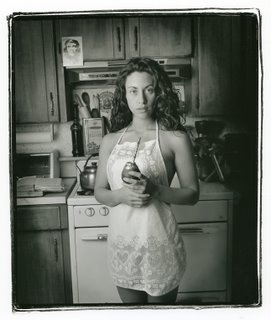
Some of them like this first one have no connection with any Argentine nostalgia. They are simply photographs of an ucommonly beautiful woman. The photograph of Lorenzo in Nora Patrich's kitchen was our salute to Doña Petrona who published cook books in Argentina in mid 19th century and taught a a generation of mostly Argentine women how to cook.
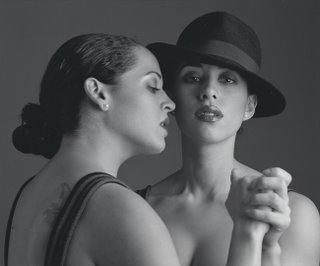
The other pictures feature Lorenzo dancing the tango with her sister, with one of Nora Patrich's paintings and finally a country girl from the interior of Argentina all fixed up by Nora Patrich. And I must mention here that any excuse to post pictures of Linda Lorenzo can never be a feeble one.
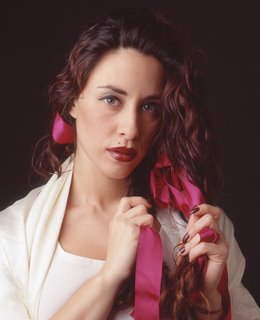
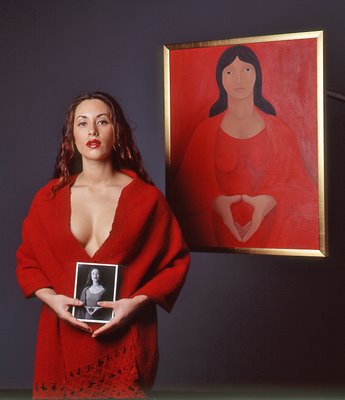
Linda Lorenzo
More Linda Lorenzo
Even More Linda Lorenzo
And Even More Linda Lorenzo
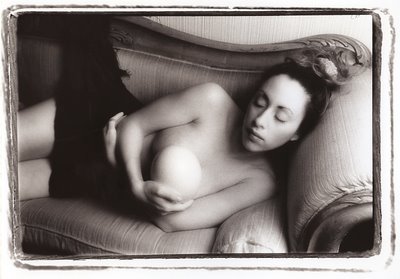
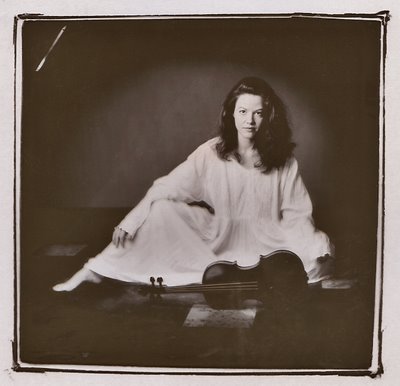
Last night I attended a dance performance at the Vancouver Dance Centre on Davie and Granville. I went with VLM editor/art director Bob Mercer. I wanted him to see a bit of Vancouver's art scene. The evening featured Wen Wei Dance and Lola Dance. Neither Mercer nor I were disappointed by the evening's performances. If anything is showed how our local dance companies try to explore and innovate beyond established parameters of what dance "should" be. It reminded me of my first work years ago with Ballet BC dancer Laurie Stallings, below, right.
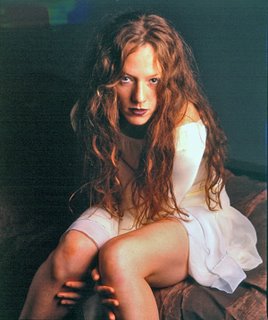
We were trying to go beyond the image of the ballerina as a swan. We wanted to show how ballerinas are women, who sweat and breathe. These photographs were a beginning for me in my search of what I now call anti-dance photographs. I also tried to to the same thing with the cliche idea that musicians can only be photographed in one way. With Vancouver Symphony violinist Karen Gerbrecht I took some pictures where we tried to convey her love/hate relationship with her violin. These attempts at taking uncliche photographs have helped me sharpen my approach to photography and portraiture.
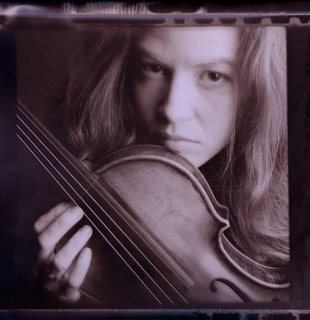
What is most evident is that our city is not too large that one cannot chat, and compare notes with dancers, choreographers, musicians, composers, actors, directors and singers. I do it all the time and it part of the fun of attenting cultural performance in Vancouver.
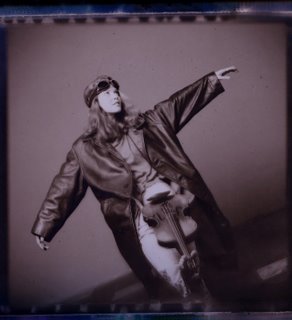
Rebecca enjoys going back stage with me after Ballet BC events. In one very special one dancer Simone Orlando took Rebecca by the hand and went into her dressing room where she presented a thrilled Rebecca with a pair of her own pointe shoes. When Evelyn Hart comes to town we visit her backstage and Rebecca gives Hart peppermint patties so that she will gain weight. Rebecca is not afraid of chatting with very tall dancer Carolyn Farquhar or telling cellist Peggy Lee that her playing was superb.
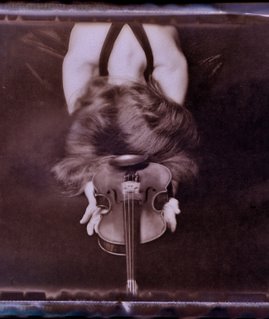
I sometimes despair that more people do not take advantage of this wonderful pleasure.
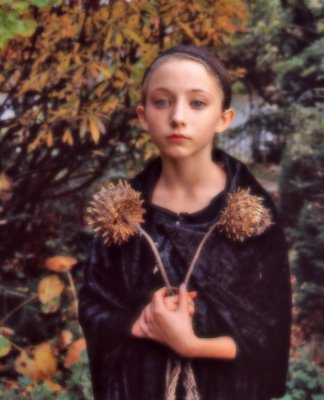
On a Tuesday a month ago I was standing on Broadway and Granville waiting for my B-Line bus to UBC. On its last stop on 10th Avenue and Sasamat I walk half a block to my class at Focal Point. My cellular phone rang and Mark Budgen (bottom) asked, "What are you doing on Broadway and Granville?" I then spotted him on the other side of the street. We chatted for a few minutes and he invited me to accompany him to Opera Sushi. He explained the place. I was intrigued but I had to decline as I had to teach.

About three weeks ago I picked up Rebecca at her dance class on 4th and Alma and suggested we try out a new place on Broadway called Opera Sushi. Rebecca was interested. We went. Opera Sushi is a small restaurant half a block west of Fir. The walls are decorated with old opera LPs (long playing records). There is a large TV monitor with an opera on at all times. The sound in the restaurant (a singer singing opera) does not always coincide with the action on the TV. As soon as we ordered the music was mysteriously changed to Frank Sinatra. It was 7:45pm and we were the only ones in the restaurant so we took our chances and asked for more opera. The Japanese man behind the counter smiled. We were rewarded with sound matching the beautiful woman on the screen singing her Violetta in Verdi's La Traviata. She was Rumanian Angela Gheorghiu. Her handsome Alfredo was American Frank Lopardo. We listened and watched until Rebecca finished her salmon sushi which she said was perfect. We reluctantly left.
Last night after picking up Rebecca at her dance she immediately asked me, "Are we going to Opera Sushi?" I had forgotten how Rebecca likes good routines. So we went. We arrived and Angela Gheorghiu was on singing Violetta, more or less where we had seen her the last time. Again the sound in the restaurant was not the sound of the TV. We ordered our food and requested the sound of our opera. We ate and then lingered and got as far as the surprise visit that Alfredo's father makes on Violetta. I was having a problem trying to explain that Violetta was a courtesan. I should not have been concerned.
As soon as I delivered Rebecca home she asked me to listen to one of her favourite songs which she first heard in her hip-hop dance class. It is Fergie's Fergalicious.
Part of the lyrics:
Fergalicious definition make them boys go loco
They want my treasure so they get their pleasures from my photo
You could see you, you can't squeeze me
I ain't easy, I ain't sleazy
I got reasons why I tease 'em
Boys just come and go like seasons
I left deciding I was not the one who was going to ask Rebecca to explain those words. In the middle of the night I wondered how many times we would have to go to Opera Sushi to listen and see a complete Traviata, opera redux.
Opera Sushi
1640 West Broadway
Vancouver, BC
(604) 737-1030
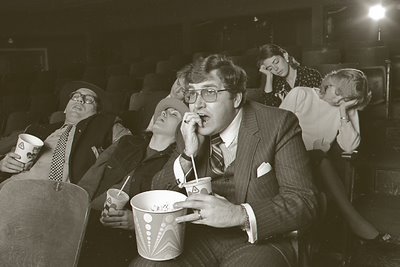
It was around 1972 that my Spanish neighbour in Mexico City and I found out we both read science fiction. We exchanged books. He gave me a Stanislaw Lem and I gave him Olaf Stapleton's Hacedor de Estrellas. A month passed and we returned the books after having a short chat. I had not read the Lem book and I am sure he never gave Stapleton's book a chance. We still managed to express or views re Polish/Russian science fiction versus the rest of the world. What comes to mind is the recent translation into English from the French of Pierre Boyard's How To Talk About Books You Haven't Read.
I mention the above because with only a perfunctory look at local media I feel I have seen all those films that I haven't. It seems that our whole Vancouver culture, particularly as noted by our Vancouver Sun ,is all about food, fashion, gossip (movie gossip) and Hollywood films. That lefty rant, The Tyee does not welcome much cultural content unless it is about TV and film. The logical explanation is that this fine BC web magazine must cater to not only Metro Vancouver but the interior. The only aspect of culture that binds all those communities is viewable on a TV screen or computer monitor. That eliminates ballet, dance, theatre, the visual arts, symphony music, baroque music, opera, new music, etc. We are to be defined by our reaction to film and TV. Vancouver's leading blog aggregators also stress food and even sports as arts.
I have vowed not to rant here nor write about politics or religion. I have especially vowed not to review films. That is why I will not complain about the pervasive media emphasis on film. I will read my reviews in the New York Times and enjoy such flops as Steven Soderbergh's The Good German to my heart's content.
As I look back to compare and contrast what was film criticism then and what it has become, I must note that I miss the Vancouver Sun's Les Wedman who later reviewed films on television. He had a pleasant demeanor and he did his best to like the films he reviewed. He was never nasty or cruel.
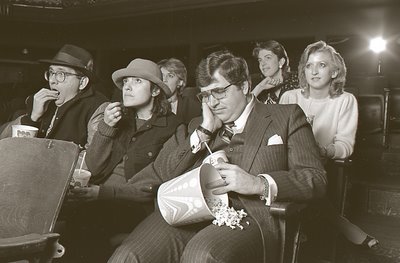
But I also miss the whacky, down home reviews of Rick Forchuk (seen eating pop corn above and left). He reviewed movies for Harvey Southam's and Pia Shandel's (and Daryl Duke, too) CKVU. Please, Mr. Forchuk come and save us from all these film critics. Tell us about the movies you like.
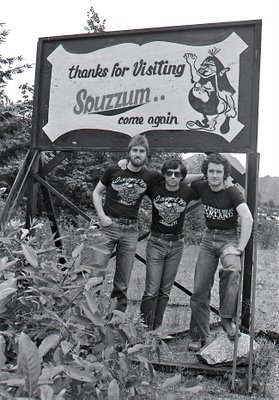 Coming back yesterday from a two-day visit with our daughter Ale in Lillooet, Rosemary, Rebecca, Lauren and I stopped for a rest and some food at the Charles Hotel in Boston Bar. I wasn't going to tell anybody about my previous experience there except Rebecca suddenly said to me,"Doesn't that man that just came in look like Ian Bateson?" The man did and I had to tell Rebecca about it all.
Coming back yesterday from a two-day visit with our daughter Ale in Lillooet, Rosemary, Rebecca, Lauren and I stopped for a rest and some food at the Charles Hotel in Boston Bar. I wasn't going to tell anybody about my previous experience there except Rebecca suddenly said to me,"Doesn't that man that just came in look like Ian Bateson?" The man did and I had to tell Rebecca about it all.
It was in June 1982 that I first went to Boston Bar. Through the years I have passed it many times and even spent nights at the Charles Hotel. When I worked on contract for CP Limited I often went to Boston Bar, Lytton and other nearby places to photograph scaling (the controlled avalanching of mountain sides to prevent big ones from destroying valuable track, railroad equipment and lives) or the building of train bridges. These photographic expeditions usually happened in those summer days when temperatures in nearby Lytton would soar near 40.
Not far from Boston Bar I once stopped a train four times. CP asked me to locate a place where I could photograph Nissans, Mazdas and Toyotas on CP Rail cars so that photographs could be sent to Japan as gifts to Japanese car executives. I chose a place not far from Boston Bar where CN and CP changed sides on the Fraser River. One bridge took the CP tracks from one bank to the other and a CN bridge did the same in the opposite direction. In this place there was river, forest, mountains and briges, a suitable iconic Canadian site for a photograph. With a walkie talkie in hand I stopped the train and then slowly I made it advance to the rail car with the Nissans. I would then take my photograph. Then I did the same for the Toyotas and the Mazdas. It was thrilling to be able to stop and start a near mile-long train.
But it was the first time I went to Boston Bar, that biker ball in June of 1982, that has firmly left an impression on me. I noticed that the Cog Pub has been re-named. But the restaurant is much the same as the one where Les Wiseman, Ian Bateson and I nursed a terrible hangover the next day after our biker bash experience. I pointed out to Rebecca the very booth where we sat (very close to where the waitresses dropped the soiled dishes, back then, we thought they were throwing them) that morning. Every time the dishes were dropped our lives would come to a crashing and painful end.
We had convinced the Province to send us to cover the biker ball. Wiseman was to write it, I was to photograph it and Bateson was to serve as a possible illustrator. Tarren at the Drake Hotel had given us the name of our contact, Blackie. Afraid that bikers might trash our personal cars we rented a metallic orange Toyota Tercel. Our afternoon and evening at the biker ball faded away from our memory by the next day when the combination of biker beer and biker chicken had done all of its damage. But we did stop in Spuzzum, on our way back to Vancouver for the snap here. That's Wiseman on the left and Bateson on the right. Wiseman told me he never finished the story. Perhaps the reason could have been that one of the bikers, as we left the proceedings, told me, "Tell your writer friend, not to fuck up."
But when I looked for pictures in my photo files last night I found Wiseman's unfinished story. He must have given it to me. So here it is.
Bikers
By Les Wiseman
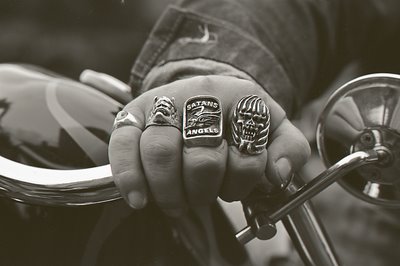
We were sitting in the Canyon Inn Pub a few yards off of Trans-Canada 1 in uptown Yale. Our nerves were jangling as we drew nearer to Boston Bar, site of the June 20 1982, Biker’s Ball, so we had stopped for a tranquilizing frosty. Our conversation had one central theme: We were probably going to get the living bejeezus beat out of us by liquor-crazed bikers who could and more than likely would crush our skulls like American beer cans. Doomed. A strange feeling took hold; we knew this weekend would not be boring. Our senses became keen like any sort of prey. Through our heightened hearing the rumble made us twitchy before we could identify it. Then the cold blue flame that runs from your throat, through your stomach and pans out into the genitals ran its course as we recognized the sound of motorcycles. Big ones; a lot of them.
We had not seen any bikes on the way from Vancouver and suddenly there were a dozen hogs, Harley Davidson 1200s with teardrop gas tanks and extended chrome forks filling the parking lot, revving their engines. Their riders, with their shades, short helmets, ragged beards and hair, sleeveless leather and blue denim jackets were coming into the bar, and we were just leaving. Looking decidedly working-class and sheepish we sulked back to the Toyota Tercel. We were out of our league; but committed to experiencing the whole affair, regardless – well, within limits.
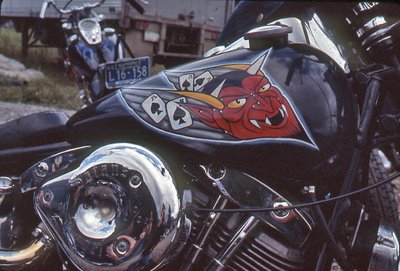
More choppers passed us, singly and in pairs, winding around the turns and echoing through the tunnels. A fluid streak of motion zipped by, cut in front of us and pulled over. Through the rear window we could see the rider stumble off his bike, hurl his taped helmet to the gravel, stagger to the cliff face rising a hundred feet above him, leaning his forehead to the stone he fumblingly relieved himself, weaved back to his bike, and at the Hell’s Gate Tram he soared past us again, poetry on wheels, complete and competent in chain-drive movement.
A mile or so further, we noticed a large yellow field irregularly mosaiqued with small dark figures and lines of glittering bikes- the site. But first, a trip into the village of Boston Bar to weigh the sentiments of the locals. And to buy beer, a generally accepted form of life insurance. The folk seemed non-plussed, excited even. Sure, they were all going to go down to the site for a while, everyone who had talked to a biker had been cordially invited. Kids hung around gas stations leaning on bicycles equipped with ape-hanger handlebars, mouths catching flies as they watched the celebrants fuelling and polishing their Harleys. In the Prince Charles Hotel bar, The Cog Pub, baseball-capped good ole boys wandered up to tables of bikers and struck conversations regarding horsepower and mags versus spoke wheels.
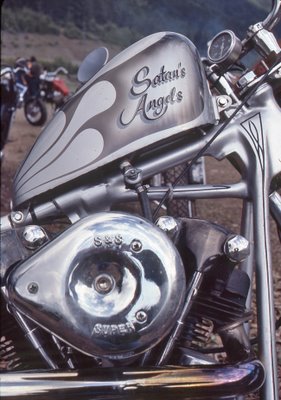
At the gateway to the field we were stopped by some guys drinking in the back of a pick-up. They asked for a donation to aid the cause of publicizing and defending the protest against the helmet laws. We gave them a couple of bucks apiece and got our hands stamped. Unthinking, I asked for a receipt. They all looked at me with loathing. One of them spat very near to the Tercel’s fender.
Looking like blatant narcs, we cracked a couple of beer and wandered over to the bonfire. We stood, trying to appear cool, yet looking out of place as F.B.I. agents at Woodstock. The photographer pressed his contact. “You know Blackie?” he asked a nearby biker. The guy looked him up and down, for an intimidatingly long moment. He nodded. “Oh, well could you point him out to me?” The biker shook his head. “Who should I say is looking for him, if I see him?” he asked. The photographer told him. The biker nodded and walked off.
We stood some more. Parallel to the drop-off to the Fraser River was a stand of two-by-four studs clad with walls and roofs of plywood where they sold T-shirts and cans of Molson’s Canadian and highballs. Beside that there was a similar structure for feeding. Beside that, there was a cooking area where chicken halves were being barbequed. A make-do bandstand was a few yards away across the sawdust laid in the heavy traffic area. Off to one side, like Dracula’s castle in a Hammer film loomed the latrines. Choppers, inert without their masters, metal steeds at graze, punctuated the landscape like slalom obstacles. The clear canyon air vibrated on the upper level highway as a duo of bikes torqued into the town site making a joyful noise passing their brothers in the field below. A lot of the guys raised their beer cans and pointed, “There goes so-and-so!”
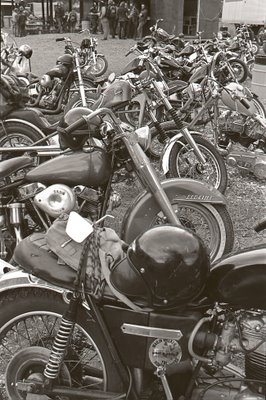
We had been told that our contact was the biggest, meanest looking Indian guy wearing a cowboy hat, you’d ever seen. Profits from the beer sold at the concession were going to the anti-helmet law cause, so we had stopped drinking our beer and had been buying from the stand. Only polite. The clear, lucid, crystalline fear of a few hours before was losing its edge. So when a man vaguely matching the description strolled over, we were feeling more in sync with the ambience. He told us he had known who we were from the moment we had walked in. Indeed we had stuck out like pimples on a sore derriere. We talked. Wondering what was going on, a few more guys came over to listen in. They were Satan’s Angels, a big bike club with members from all over B.C. Most of the participants at the ball were Angels. They wore their colours, crests consisting of a red horned black bearded devil-head with golden halo on the back of a sleeveless black leather jacket. They were like normal people: fat, skinny, tall, short, muscular, wimpy, short-haired, long-haired, mostly bearded, a larger than normal percentage had limps, evidence of going over the edge on a bike. Some used canes; they had to kick-start their bikes while in unusual bodily configurations. All decidedly tough, though. Yet, the thing that struck me the most was the fact that there seemed and unwritten custom, that when dealing with outsiders, it was considered proper to be as quiet-spoken, and articulate as possible. They did not give us any flack. They simply told us that it was up to each individual member as to whether or not he would allow photographs or conversation. To be reproduced in print. Our admiration grew. They told us that they had, almost invariably received bad press. We told them that we were serious professional journalists and told only the truth. They told us that they knew our phone numbers and names should we be lying. We told them that we admired them. That was the truth. Fear had transformed itself into understanding. We were happy to be there, to escape the mundane aspects of working-class life. We were not bored.
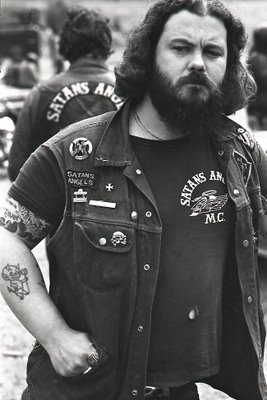
"Show us your bike," we asked one fellow.
Lou Reed in Boston Bar
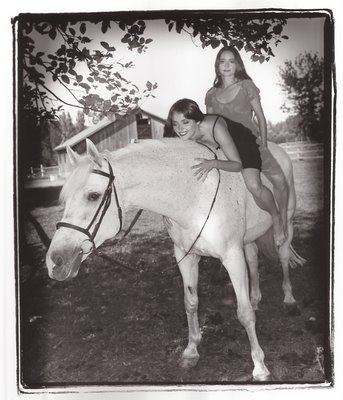
Fashion and I have never really gotten together much, as I wrote here. But there was another occasion. It involved finding a horse and a bunch of grapes in an Abbotsford farm. John Lekich had written and essay on female elegance and I had an idea on how to illustrate it. Unfortunately shooting for a family publication, in this case the Georgia Straight somewhat thwarted my total vision. I thought that a couple of sisters dressed to kill and riding bareback would somehow convey the ideal of the elegant woman being elegant, no matter what the circumstances. At the time I had written a story for the Vancouver Sun on the role of women cello players in music. This was quite restricted until women were allowed to play full-frontal cello in the beginning of the 20th century. Until then, since putting your legs around a cello was deemed immoral, women were forced to play musical side-saddle with the instrument. The same idea of a woman riding a horse like a man was anathema well into the 20th.
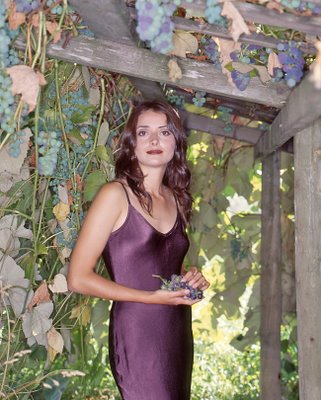
I am not sure if Miki and Nicole Ruso were wearing anything underneath for this picture of them on the horse. I was too busy trying to take the picture of the untrained horse who would not stand still to think much about it. But in the end we took our pictures and had our Straight cover and everything was back to normal.
As cliche, as the concept is, that was the first and last time I ever approached the idea of a woman and a horse. I had previously photographed a woman, quite bare, on a dressage saddle, on a saw horse in the middle of her living room, but that's another story.
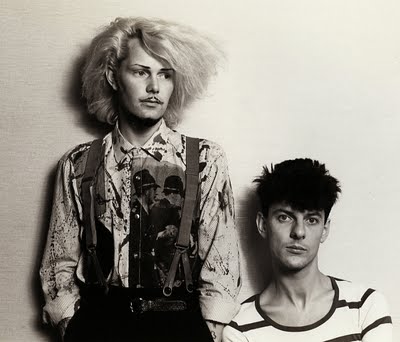
I took this photograph in 1982 of Modern English members Gary McDowell and Robbie Gray. They were of a British wave of musical groups called New Romantics. They were pleasant and the very opposite of the Vancouver punk bands that I really liked. But I do remember this photograph which had a particular look I could not possibly replicate today even though I still have a few rolls of the film I used. It was Kodak Technical Pan 2415 film which was the only film that matched the resolving power of the best lenses at over 200 lines per millimeter. It was extremely sharp film and when used in 35mm cameras it had the look of photographs taken with much larger formats such as 4x5 inch cameras. The film had an extended red sensitivity which tended to make skin shine and blemishes disappeared.
Today's blog is a kind of holiday. Rosemary, Rebecca, Lauren and I drove to Lillooet yesterday to visit our daughter Ale. We will return Monday. For breakfast we are having thick bacon, toast and a Yorkshire blend (very strong) tea from Granville Island Tea Company.
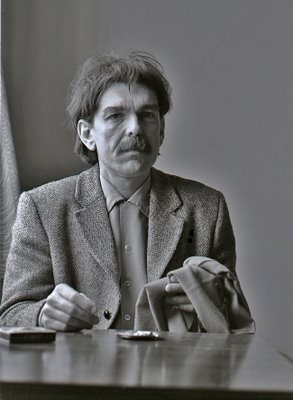
Ashtray Heart (From Doc At The Radar Station 1980)
You used me like an ashtray heart
Case of the punks
Right from the start
I feel like a glass shrimp in a pink panty
With a saccharine chaperone
Make invalids out of supermen
Call in a "shrink"
And pick you up in a girdle
You used me like an ashtray heart
Right from the start
Case of the punks
Another day, another way
Somebody's had too much to think
Open up another case of the punks
Each pillow is touted like a rock
The mother / father figure
Somebody's had too much to think
Send your mother home your navel
Case of the punks
New hearts to the dining rooms
Violet heart cake
Dissolve in new cards, boards, throats, underwear
Ashtray heart
You picked me out, brushed me off
Crushed me while I was burning out
Then you picked me out
Like an ashtray heart
Hid behind the curtain
Waited for me to go out
A man on a porcupine fence
Used me for an ashtray heart
Hit me where the lover hangs out
Stood behind the curtain
While they crushed me out
You used me for an ashtray heart
You looked in the window when I went out
You used me like an ashtray heart.
I took these pictures of Captain Beefheart sometime in 1980 at the Hotel Plaza on Burrard the day he appeared with the Magic Band at the Commodore (third photograph). This was one of my earlier collaborations with writer Les Wiseman for his In One Ear column in Vancouver Magazine. Wiseman had told me that if he had to go to a desert island with one record (there were no CDs yet) it would be Beefheart's 1969 Trout Mask Replica . Such was the complexity of this record's music that it would take years to figure it out and one would never tire of it.
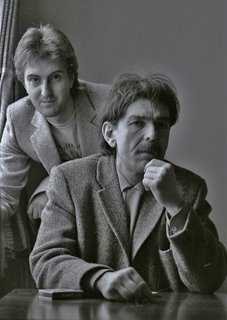
In the hotel Wiseman gave Beefheart a pack of Gitanes to smoke. All three of us were wearing Harris Tweed jackets. Beefheart impressed us with his knowledge of how many dyes were involved in their making. We also discussed the horsemanship of rejoneador Don Álvaro Domecq who fought bulls from beautiful white horses. I had seen Don Álvaro in Mexico City and Beefheart wanted to know more.
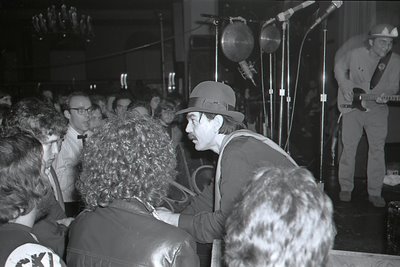
What remains most in my memory of that day was listening to Beefheart sing the line: Somebody's had too much to think and then he stopped and stared at the young man in the picture.
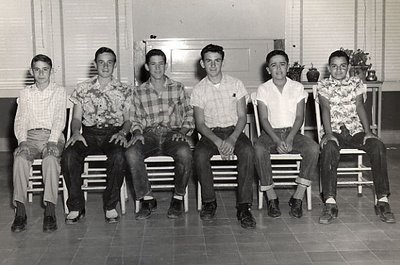
I wrote about the above photograph here and in the last few days I have been able to locate all but one of the young men.
The breakthrough ocurred when I remembered Remigio Martinez's (last on the right) maternal name Mueller. With his complete name I found him as Vice President, Exploration of Southern Copper Corporation. He replied to my email:
Alex,
I received your communication. How are you? As you can see I am continuing the family tradition working for what used to be ASARCO. I now live in Hermosillo, Sonora in Northwestern Mexico. If you ever come this way let me know so we con meet. I have especially fond memories of your mother. Is she still with you? Both my parents passed away about 4 years ago. I still keep in touch with some of the guy and gals we went to school with,. Do you? Anyway let me know how you are doing. I do get to Vancouver every once in a while, I´ll look you up next time I go there.
Saludos,
Remigio
That's me on the left. Next is Steve Frazier (I am not sure if that is Frazier or Frasier). He lived in a large ranch near Sabinas, Coahuila with his genteel mother and lovely sister Cornelia. After we "graduated" from the 8th grade Steve's mother took me as far as San Antonio to the Greyhound Bus Station several times after a Christmas holiday from my boarding school at St Ed's in Austin. In the car I would be with the remote and extremely lovely Cornelia who we would dropp off in Uvalde, Texas. Steve taught me to shoot with German elephant rifle and took me for rides in his US Army Surplus Jeep in the Coahuila scrub. When I talked to Sammy Simpson yesterday (next guy and below) he told me, "Steve is my cousin. The last I heard he married a girl in Muzquiz, Coahuila and went to Mexico City where he disappeared."
I found out from Remigio Martinez Mueller (last on the right) that Sammy was living in San Antonio and was not in good shape. So I Googled Sam Simpson, San Antonio and called him up. Sammy was a bit cautious at first but I then immediately recognized his voice with its Texan drawl. He told me, "My wife is in hospital and I am here in the living room with my dog watching the news. I had a boring life." I asked him that seeing he was Texan, was he by any chance a right wing Republican? His answer was short, "I am nothing." I reminded him that it was from him that learned of things I had no idea. One day, October 9, 1956, he arrived at school and gave us a blow by blow description of Don Larsen's perfect game against the Dodgers in the World Series the day before. I had no idea what baseball was much less a perfect game. On another day he arrived singing Blue Swade Shoes. I had never heard this song or did I know who Elvis Presley was. Sammy did not remember this nor did he remember that he drove a 1957 Ford which to my disappointment was the short one and not the long Fairlane 500. Sammy has no email but thanked me for calling me. While Remigio Martinez Mueller had told me that Enrique Serna, second from right had died last year I did not know how to locate Dicky Forns, third from right. It was Sammy who corrected me , "Dicky Juvé Forns." With that I located Dicky and here he is.
HAI Announces Recipient of the 2005 Outstanding CFI Award
Alexandria, Va., December 8, 2005 – Richard “Ric” Juve Forns, Senior Flight Instructor, Bell Helicopter, Fort Worth, Texas, is the recipient of HAI’s 2005 Outstanding Certified Flight Instructor Award, which will be presented at the 2005 “Salute to Excellence” awards banquet. This award recognizes superlative contributions by a helicopter flight instructor in upholding high standards of excellence. Forns has been a flight instructor for 35 years, with 10,000 hours of flight instruction, and over 3,000 students. He has amassed more than 22,000 accident- and violation-free flight hours. His flying career began in the U.S. Army at Fort Wolters, Texas, and continued with advanced training at Fort Rucker, Alabama, and service with the 114th Assault Helicopter Company in Vietnam. Forns has instructed at the Bell Helicopter Training Facility for the past 15 years. He speaks fluent Spanish, and has hundreds of flight instruction hours with Spanish-speaking pilots. Forns has worked as a flight instructor in Canada, Mexico, Guatemala, El Salvador, Nicaragua, Honduras, Panama, Colombia, Venezuela, Ecuador, Peru, Chile, Argentina, Brazil, Taiwan, Philippines, Iran, Greece, Spain, France, Germany, Czech Republic, Netherlands, and Belgium.

He is an FAA Aviation Safety Counselor, and has conducted safety seminars on various human factors and flying topics for many audiences.
In addition to the Outstanding CFI award, Forns has earned the Distinguished Flying Cross, the Bronze Star, the Purple Heart with Oak Leaf, the Meritorious Service Medal, the Air Medal, the National Defense Service Medal, the Vietnam Service Medal, and the Republic of Vietnam Campaign Medal.
For seven years, Forns conducted recurrent training with members of the Tucson Police Air Support Unit, in Tucson, Arizona. Forn’s teaching style works well with both beginners and experienced pilots. He is able to stimulate the students’ thinking, allowing his students to assimilate information, and apply it to their flying skills. He is a successful instructor because he can communicate with his students and make the lessons relevant to them.
Somehow, soon I will locate Steve and when that happens I will be able to close a little box and tie it up with a neat ribbon. I will be closing another period of my life. When I sent my friend Howard Houston (he piloted a KC-135 re-fueling fighters in Vietnam) Rich's war record he commented:
I have known several of these helicopter jocks who served in Vietnam. Without exception, they were "good guys" who had a somewhat loose definition of what was too dangerous to do on a regular basis.
You don't get a DFC or a Bronze Star for being careful.
As an instructor pilot for Bell, he gets to deliver their equipment and train the receipients all across the world. A most interesting job, I would think.
HH
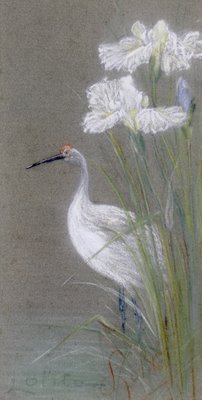
I have written about our guest bathroom before here but I need to do so again. It all has to do with the difference between women and men, in so far as to our approach to bathroom use. If Rosemary were writing here about our guest bathroom she would be writing from an altogether different perspective. She would be sitting down and she would gaze at many family photographs that hang on the opposite wall. But since I stand up (for half of my evacuation chores) I get to stare at a different wall. On that wall hang three of my grandmother Lolita's pastels which she finished not long after her first communion sometime in the late 1880s.
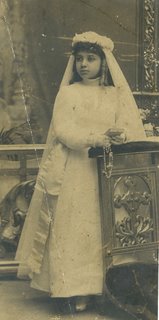
They have had many different frames. The latest ones (the framed pictures are much too big for my scanner) are nice wooden frames done in Veracruz sometime in the late 1960s. I had them re-matted in Burnaby around 1980.
I cannot use the bathroom on any given day without being hit by waves of nostalgia for my abuelita . If I ever acted in some odd way in my chilhood or when I was older it was explained that I was much like my grandmother. It was she who urged my mother to get me a guitar teacher (and abue bought me a beautiful Argentine guitar that was wasted on my meager musical talent) and an art teacher.
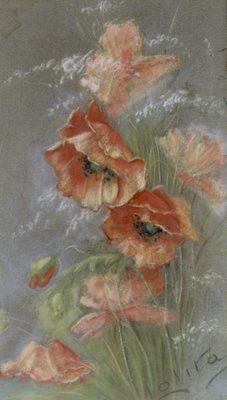
I know that she would, of all the members of my family, understand Rosemary's and my urging that Rebecca's obvious artistic talent should not be ignored at the expense of a purely scholastic approach to her education.
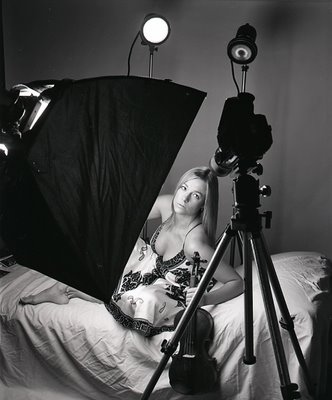
Amidst all the attention given to the sciences as to how they can lead to the cure of all diseases and daily problems of mankind, I believe that the biggest breakthrough will be the realization that the arts, which are conventionally considered "useless," will be recognized as the whole reason why we ever try to live longer or live more prosperously. The arts are the science of enjoying life.
John Maeda
Muriel Cooper professor of media arts and sciences at the Media Laboratory of the Massachusetts Institute of Technology.
Last night I was one of the happiest of men. I attended a warm and exquisite concert by Early Music Vancouver that featured Andrew Manze and Richard Egarr. I was happy because I was there with my friends Abraham Rogatnick and Graham Walker. I was happier still because I had lured my wife Rosemary who was enthralled by the down home virtuosity of Andrew Manze ("Aw shucks I play the violin better than just about anybody in the world but I am not going to tell you this.") and Richard Egarr ("Aw shucks this classical fortepiano that looks like a glorified music box is so easy to play that anybody could do what I do.") The 20 minute pre-concert talk by the pair was part stand-up comedy and a spirited apology as to why they play music and (thank God) did not choose a career in plumbing.
We were asked for questions so I asked Egarr why he was not wearing his usually loud ties. He seriously(I think) told us that we were lucky to see them in clothes as the airline had lost their luggage.
From the atmosphere of an intimate concert in a neighbourhood church (in this case Shaughnessy Heights United Church) complete with coffee, juices and home-made cookies at the interval I cannot fathom why flocks of people will converge on a concert at the Orpheum featuring, perhaps a Schubert Symphony when for less money they might enjoy as I did (and from about three metres away) a Schubert violin and piano sonata.
In the concerts of the Pacific Baroque Orchestra (all held in churches) and in the majority of the concerts of Early Music Vancouver I never feel a barrier between the musicians and myself. We are welcomed to talk to them back stage or sometimes they mingle during the interval. I have seen my friend Paul Luchkow, a violinist with the PBO almost lose that infectuous smile of his when he plays sitting down in his other gig as a violinist for the VSO.
The exception to this difference between the warm congeniality of the former with the colder and more serious latter seems to be the Artistic Director of the VSO, Bramwell Tovey whose banter and easy to understand explanations of the musical goings on I appreciate. Another exception is VSO violinist, Robin Braun (above, left) who understands that if her career in her profession is going to evolve and prosper she has to promote it from the side. And she has an unusual web site if you realize that most symphony players don't have one. Braun is an accessible musician who shares a bit of that disarming ("What I do isn't as impossible as you might think," attitude of Manze, Eggar and Luchkow).
As I discussed with Luchkow last night the less than good attendance of the concert I wonder why there has to be that barrier between the audience of a symphony orchestra and the musicians and a barrier between those who attend the Orpheum concerts and those who opt for neighbourhood church concerts.
The virtuosity of Manze and Egarr is no less than those of the super musicians lured to play in Vancouver for the larger musical organizations. After listening to Manze and Egarr explain (with on the spot examples with their instruments) how an 18 year-old Schubert was influenced by Mozart I could now attend a Schubert symphony at the Orpheum and get that much more. But would I mingle with the musicians and bite on homemade cookies? I think that our city's musical companies should get together and compare notes.
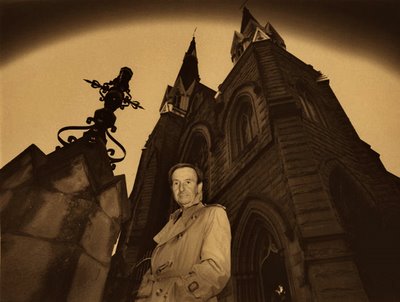
He went to the chest in which vestments were stored and took out a linen alb, pulling the long white smocklike garment over his black cassock. He took up a gold-embroidered stole and, from habit, touched his lips to it before putting it around his neck. He walked past the dead priest, going to the door....He looked up at the sky. Soon winter snows would cover this vast, empty land. Here among the Savages, he would spend his life. He poured water on a sick brow, saying again the words of salvation. And prayer came to him, a true prayer at last.....
Black Robe, Brian Moore 1985
Photographed at Holy Rosary Cathedral on Dunsmuir and Richards.

Sometime in April 1991 the editor of Quill & Quire called me up and said, "Alex how would you like to photograph a 6 ft tall lesbian?" I was speechless, even after he said, "Your subject is going to be writer Jane Rule. The piece on her is that she is going to retire from writing because of her terrible arthritis which prevents her from articulating her fingers."
I did not know what to expect as I waited for her to show up.
In 1978 I had photographed a woman for a gay publication called Bi-Line. She was extremely beautiful and she was a lesbian who was treated by other women as a queen bee. They vied for who would wash her car or clean her house. She was obvious royalty. We met for coffee to dicuss our photo session and decided on dressing her in her karate clothing and I would photograph her after her workout. As I listened and stared at the woman I felt this incredible relaxation that as a man I did not have to worry about my sexuality, to make any kind of passes and I could just be myself. It was a liberating feeling.

With that in mind I did not expect to be woowed and wowed by Jane Rule. I fell for her immediately as she posed for me with her owl glasses. She had a delightful dress and she carried herself well considering she was big woman. At the end of our session she said to me, "Alex, I will need your help to go down the stairs and I would like you to find me a cab." As we walked down the stairs hand in hand I thought of that cliche that applied so well to the situation:
A lady is a woman that makes a man feel like a gentleman.
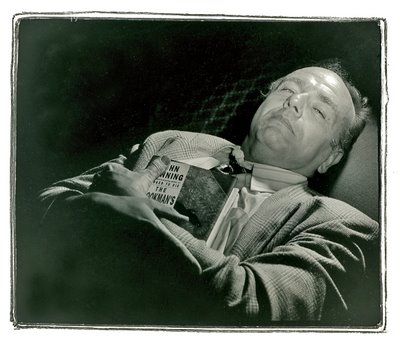
"It's a Book-of-the-Month Club first," Nuff said enunciating each word with chilly distinction. "It's printed from the same plates as the first, or maybe even the same sheets are used; that's why it says first edition. But the binding is different, there's no price on the jacket, and the book has a blind stamp on the back board."
"How much is it worth?"
"This book? Five bucks, tops. There are eight million copies of it in the naked city."- from Booked to Die(1992), by John Dunning
Rosemary refused. I had asked my wife to call the Book-of-the-Month Club to cancel my membership. She was to tell them she was a recent widow. The next time, I did the calling. I wasn't swayed by their, "Sir, our records show you have been a member since May 15, 1975. Are you sure?"
It all began in 1968, when I was living in Mexico City. A friend had a diplomatic passport with access to the diplomatic pouch which meant she could bypass the notorious Mexican postal system. She bragged about the book deals she got from BOMC. I lusted after her unabridged Random House Dictionary of the English Language. But Even though I tipped my mailman at Christmas and for el día del cartero (Postie Day), I never got more than eight or nine of my National Geographics in any given year. The others would get "lost." I could never be a member of the BOMC.
When I arrived in Vancouver in 1975, I joined almost instantly. It was a happy day when I got my first shipment of "free" books. It included a copy of William Shirer's The Rise and Fall of the Third Reich.
Selecting and ordering my new books became a pleasant routine. Thanks to the BMOC I was exposed to John Updike, Margaret Atwood, V.S. Naipaul and Anthony Burgess. I discovered Elmore Leonard, P.D. James, Tony Hillerman and Colin Dexter.
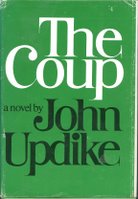
It wasn't all fiction. I got hooked on Stephen J. Gould and Richard Dawkins. And there were all those wonderful reference books, like Benet's Reader's Encyclopedia and John Ayto's Dictionary of Word Origins.
When my friends (and in particular Paul Grescoe) told me my books were worthless, I countered that no dollar value can be placed on the pleasure of reading a good book.
By the early '90s my BOMC buys were being supplemented by purchases at local bookstores. Authors who interested me - Jerome Charyn, J. Robert Janes, even Walter Mosley - were not offered by the club. Not that my tastes were especially stuffy. BOMC also did not carry Bernard Cornwell's terrific but lowbrow Richard Sharpe series, set in the Napoleonic Wars. I gobbled them up as well as Stephen Coonts' The Flight of the Intruder.
By then I had discovered Manhattan Books (now Sophia Books), so I could read my favourite writers in Spanish": Alejo Carpentier, Homero Aridjis and Paco Ignacio Taibo II. I started losing BMOC order forms beneath piles of faxes and other places. Unwelcome and unordered Stephen Kings started appearing at my front door.
Then, in 1996, I met mystery writer John Dunning (above)and read his novel Booked to Die, about a Denver cop who is also a collector of first-editon fiction. The motive for the novel's multiple murders centres around what appears to be a worthless BOMC collection.
Booked to Die with its antiquarian-bookstore atmosphere, rings true because Dunning is also a keen book collector. In the novel, he reveals the crazy prices popualr first-edition fiction can fetch.
A friend, a local book collector Robert Blackwood, told me those prices could be corroborated on Abe Books, a web site with more than 50 million listings compiled from antiquarian bookstores in North America and elsewhere. There I found that Stephen King's Salem's Lot is valued at $450, Anne Rice's Interview with the Vampire at $2000 and my BOMC version of John Updike's The Coup at $5 (while the real thing goes for at least $50). Not surprisingly, Dunning's Booked to Die goes for at least $1000. And if your search in Abe you will discover that there is such a thing as an early as opposed to a later first edition. The price between those categories can be huge.
Also from Booked to Die , I learned that a good, clean first edition is worthless if:
1. The dustjacket has been clipped. It seems some booksellers routinely do this to BOMC books' jackets to hide their lack of price.
2. It contains a written greeting or dedication from anyone but the author.
While I do not regret my club years, I no longer want my books to come to me at the front door. Part of the fun of acquiring books is reading reviews and going out to look for them.
Now that Manhattan Books has resurrected as Sophia Books I can find or order Saramagos, Pérez-Revertes and Taibos.
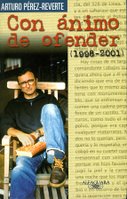
When Mystery Merchant on 4th long closed I bought my mysteries or ordered them at Granville Books. When they closed I had to start going to Chapter's. But I have also discovered the pleasure of browsing at the many antiquarian bookstores in town, such as Lawrence Books and MacLeod's Books.
Just don't try to sell your BOMC books to them. They won't buy, although Robert Blackwood did cite one exception. Such is the rarity of the 1952 first edition of J.D. Salinger's Catcher in the Rye (over $10,000) that pristine BOMC editions will trade for $300.
As a result of my better book-buying habits, I no longer pay "shipping and handling" charges and don't even think of the lost "bargains"."
As Ruby, the expert bookseller from Booked to Die , says, "A book has always cost about what a meal in a good restaurant costs. Did then, still does. I get sick hearing how expensive books are. Which would you rather have, a good book, or a tender steak? I know what I'd take, seven days a week."
But then Ruby did not know then of the bargain section of Chapters where one can buy a good book and have money left over for a tender steak.
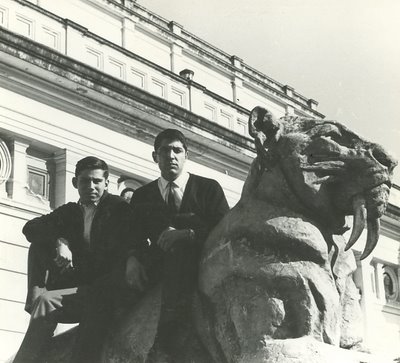
"What brings you to La Plata? Don't tell me you've come to study?"
"I've come to take photographs of the city. I'm a photographer."
The Adventures of a Photographer In La Plata, Adolfo Bioy Casares 1985
When I went to La Plata, the capital of Buenos Aires Province in 1966 I had no idea who Adolfo Bioy Casares was. My sailor friend Felipe Occhiuzzi and I had obtained a weekend leave so we had decided to take a bus to La Plata and visit the La Plata Museum, famous for its dinosaur finds. We managed to find a pretty girl to snap our picture in front of it with my Pentacon F camera.
We managed to find a pretty girl to snap our picture in front of it with my Pentacon F camera.
This Tuesday during a break of my class, The Contemporary Portrait Nude, at Focal Point I went for a coffee at Bean Around the World which is next door on 10th Avenue. There in one corner I spotted my friend Brian Nation (a photographer, poet, writer, web designer, etc) and Canada's first ex (2002) poet laureate, George Bowering. Both smiled and I never got to sit down as Bowering said, "Alex, I am going to Buenos Aires. My favorite Argentine writer is Bioy Casares. Do you know where he lived in Buenos Aires?" I did not know but I mentioned a book Casares had written about La Plata and Bowering knew all about it. I felt that somehow I had to take a picture. But all I had was my very large Mamiya RB in a small bag. I took it out and measured the light with my Minolta meter. The exposure was was f-5.6 at 1/8 second. That was iffy but I slapped on the Polaroid back and took this picture that you see here. I gave it to Brian Nation who posted it the very next day in his blog. I downloaded it to here.
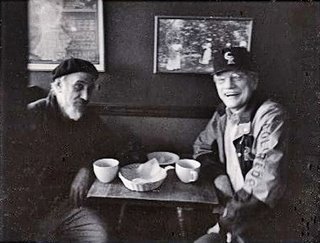
Some years ago I had to photograph Bowering for Books in Canada. I took Bowering to Nat Bailey Stadium to take some baseball shots.
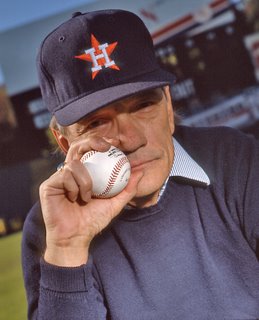
One of the pleasures I used to have when Duthie Books on Robson existed was to visit the store and sometimes buy a book which I would then peruse in the Murchie's store on the other side of the street. Both are gone. But I fondly remember going up to Thea, (Bowering's daughter) who worked in Duthies and I would ask, "I am looking for a book called The Poet In Danger of Extinction." At first she was extremely serious in telling me that no such book existed. Then, when she caught on, she would just smile. Her smile was just as infectious as was Bowering's when I told him this story on Tuesday.
In Mexican poet/novelist Homero Aridjis's Eyes to See Otherwise - Ojos de otro Mirar Selected Poems. published in 2001 and edited by Homero Arijis's wife and George McWhirter (born in Belfast) who happens to be our 2007 Vancouver Poet Laureate there is this poem:
The Poet In Danger Of Extinction
1
- The poet is in danger of extinction -
said the man with the moustache.
- The poet is someone from another age
who wonders through the day saying things
nobody understands - said the woman.
- While your bricklayer falls of a building,
the poet calls to us in the dead
language of mankind - said the shopkeeper.
- The poet writes books nobody
wants to read or sell or publish -
said the Professor.
- We ought to form a society
to protect these poets
in danger of extinction - said the woman.
2
- Baudelaire never was that popular -
said the man with the moustache.
- Dante, after seven hundred years
hardly anybody reads him - said the woman.
- Gongora - after the revival and reappraisal
is ignored all over again - said the Professor.
- What can we do so the public gets to know
poets better? - asked the shopkeeper.
- Nothing, absolutely nothing - said the poet.
- Didn't they say this was the type of person
who was already in danger of extinction? -
asked the man with the moustache.
3
The poet said:
String moons
through the smoggy streets;
in the world of communication
reach out through the dead languages;
in a marketplace of goods
that are smelled, pawed over, eaten
or shelved for a thousand years,
touch the body of a woman who never was.
See, in front of my bedroom window
the poet, my double, dodge between the cars,
lika an animal in danger of extinction.
Homero Aridjis
Of George Bowering's favourite Argentine writer, this is what Jorge Luis Borges wrote:
We met in 1930 or 1931, when he was 17 and I was barely past 30. In these cases it is always supposed that the older becomes the master and the younger his pupil. This perhaps happened in the beginning, but years after, when we began to work together, Bioy was in reality, while secretely, the master.
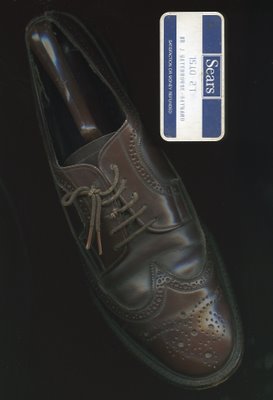
Sears and I have had a fond relationship since 1957. In 1957 I bought my mother a Kenmore beater in Austin, Texas and it worked until a couple of years ago when the motor finally burned out. The shoe you see here (the left one is in my closet) looks like a normal dark brown wingtip. But it isn't. I bought it in the Mexican branch of Sears, Sears Roebuck de Mexico SA de CV. The joke at the time(1968) in Mexico was that it was modified to be pronounced Sears Roba A Mexico or Sears Robs Mexico. I bought the pair of shoes in 1968 in their brand new store on Avenida de Ejercito Nacional Mexicano about four blocks from my Tía Fermina Miranda's house in Colonia Irrigación. What is special about these shoes is that they are not made of leather. They are made of Dupont Corfam. This was supposed to be a plastic that could breathe. Perhaps they didn't breathe enough for most people as Dupont's venture into shoe material was a failure. To make them shine a wet paper towel was all I ever needed. I rarely wear these shoes because I no longer have brown Harris Tweed jackets or cream coloured slacks. But they are in excellent shape.
When Ale (38) was 14 we were living in Burnaby. I noticed that she was growing up. So I said, Ale, let's go to Sears. In Sears I found a venerable looking matron salesperson and I said to her, "This is my daughter Ale, can you fit her with a bra?" Since then going to Sears has meant going to buy one's first bra in our family.
Sometime in 1985 we bought a washer/dryer combo at Sears. They are still working like new in our present basement. Sears Craftsman lawnmoers have not been as hardy. In 1986 when we moved to our present house on Athlone I was obsessed with the perfect lawn. I bought a re-conditioned Craftsman reel mower. I retired it when I came to appreciate the wonders of mulching lawnmowers. We are into our third Craftsman. I presently go to Sears to buy my boxer shorts. The Sears brand fits me just right.
I wonder if Hilary will tell Rebecca, "Let's go to Sears," when the time comes.
My studio is blessed with light that comes from the building across the street. It happens to be Sears
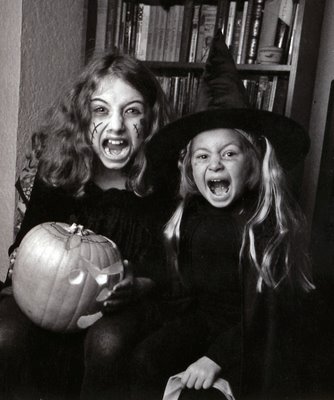
I hate halloween.
It wasn't until my waning last years in Mexico City in the early 70s, when American culture was moving south, enexorably, as Mexicans were moving north, that I became aware of the phenomenon called halloween. Street urchins would come up to me and stick their hand out and plead, "Jefe, dame mi halloween." Mexicans had become aware of the festivity perhaps thanks to the American style drugstore chain called Sanborns. Mexico had its own holiday. November 1 is celebrated as All Saints Day, and November 2(All Souls Day)is Dia de los Muertos. Recently local and federal Mexican governments have been trying to stamp out the custom of having picnics in cemeteries on the day of the dead. Families will spend the day on top of their departed loved ones'graves. Bakeries make a brisk business selling sweet bread with the shape of bones on top and personalized sugars skulls (the name of your sweetheart on the forehead and dazzling sequins in the eye sockets. The cheap tabloids have a feast day writing up the most grizzly murders of the day.
I have never been prepared for numerous and unceasing knocks and doorbell ringing.I hate halloween.
But I remember those halloweens in Burnaby in the middle 70s and early 80s when my two daughters were young girls. It often rained and they would come home cold and wet. I felt sorry for them. They ignored me as they emptied their large black garbage bags of sweet booty. I ignored their protests when I helped myself to the chocolate covered peanuts. I tried to disappear on those nights to punk rock concerts the Japanese Hall or the Odd Fellows Hall. And until now I hardly ever made myself answer the door on halloween. Rosemary has had that chore all along.
But yesterday we finally had the perfect excuse not to be home. We went to the opening performance of the Arts Club Theatre Company production of The Glass Menagerie. On the way to the Stanley Industrial Alliance Stage we stopped to snap a few pictures of Rebecca and Lauren all dressed up and ready to go for their loot. I looked at Hilary (34) and fondly remembered the picture I had taken outside our Burnaby townhouse some 30 years ago.
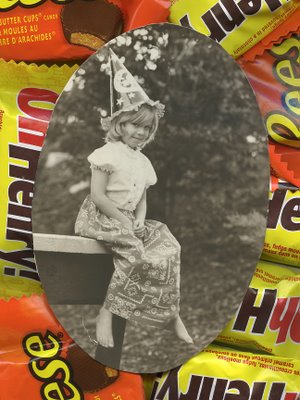
The Tennessee Williams play has an excellent cast. Gabrielle Rose with a suffocatingly good Southern accent is the perfect has-been genteel mother, Amanda. Her shy daughter, Laura is played by Cherise Clarke in a performance that reminded me of a wonderful Mare Winningham that I photographed so many years ago. Both Winningham and Clarke had a silent presence. During last night's play it seemed as the less Clark said the more Rose said. This was fascinating as I could even see a physical family resemblance between them. Craig Erickson played the overachieving Jim with convincing aplomb but it was Robert Moloney who played Tom (Laura's brother and Amanda's son) that I felt drawn to the most. His hair would stand up in such a way that I thought of an even more serious and tragic Stan Laurel.
Rosemary who is always so critical said of the one hour long first act, "That was short," to my amazement. I had an excellent time. I never had to open the door to screaming children, not even once.
Any sufficiently advanced technology is indistinguishable from magic.
Arthur C. Clarke

When I told an intelligent friend that I was researching Tim Bray, the Distinguished Engineer and Director of Web Technologies at Sun Microsystems, publisher of a popular weblog, ongoing, and co-chair of the IETF AtomPub Working Group, he countered:
“I’ve listened to an on-line interview of Bray done by another geek - lots of acronyms. It’s like they are speaking another language. Sort of like Portuguese might sound to a Spaniard. I can’t understand it. The best I can do is figure out they are talking about computer languages and systems. Your argument will be in the line of 'Tim Bray is a modern day deus ex machina. He makes things happen and no one (or almost no one) knows why.'”
My friend is right. After failing to understand the first chapter of Learning XML, by Erik T. Ray, even after repeated attempts, I concluded that computer programming is no different in complexity from a mason’s know-how for building a Gothic cathedral. While Bray pioneered search engines in the 90s, besides being the principal innovator of XML (extended markup language), he told me recently at my studio, “I haven’t done any work on XML in a few years. The other things I work on are important and interesting, too. Chances are, XML will lead my obituary.”
Tim Bray, who lives in Vancouver, defined XML for me in one sentence, “It is a method for packing up electronic data and documents so that having been packed up on one computer anywhere in the world, they can be reliably unpacked on any other computer (running any combination of software and hardware) anywhere else in the world, then or many years later, and used for whatever purpose desired, without regard to the originator’s intent.”
His answer to the question of what he did was clearer, “I help Sun by being aware of what the people who build the internet are thinking and doing (I have to help build the internet to do this.), and ensuring that those people and Sun know about each other.”
Through Wikipedia I found out that markup language is just a computer specific language, much more complex but no less useful that the original markups on handwritten or typed manuscripts by editors, and line editors for books and magazines.
XML, and most of Bray’s accomplishments, began after he went for a double major in mathematics and computer science at the University of Guelph in 1981. Bray added computer science when he realized that math teachers weren’t being hired. “In math I had worked like a dog to get Cs and all of a sudden I was getting As in the computer courses. God was reaching behind my shoulder; telling me, ‘Kiddo, this is what you ought to be doing.’ And I did.”
Bray’s road to Damascus experience happened while working at the University of Waterloo (1989-1990) with the Oxford University Press, computerizing the second edition of the OED. “We had a specially constructed search engine. In an early web publishing conference in 1994 one of the speakers stood up and said, ‘Search is going to be a good application for the new web “thing”.’ He set a bomb in my head. All of a sudden I could see how to build a web search engine. I went to live in Yaletown and worked on the engine for 6 months (I ate and drank beer at the Yaletown Brewing Company downstairs. I started the Open Text Corporation and Open Text, was a commercialized and early search engine based on the high-performance engine we employed in the OED project. We were (1995) one of the top ones and partnered with Yahoo. The way search engines are now was invented by many people inserting little contributions and Google put in the big one of link counting to rankings. I think I was the first person to number the results, 1. 2. 3….. There are little bits of everybody’s handiwork in there.”
Bray, who studied the cello for 20 years, is urbane and well read. He is a populist of sorts. He has a smile on his face when he talks about the web and especially about Wikipedia. Bray does not agree with the opinions of Silicon Valley insider Andrew Keen who in his recent book The Cult of the Amateur – How Today’s Internet is Killing Our Culture has this to say about Wikipedia,
“Wikipedia has become the third most visited site for information and current events; a more trusted source for news than the CNN or the BBC web sites, even though Wikipedia has no reporters, no editorial staff and no experience in newsgathering. It’s the blind leading the blind – infinite monkeys providing infinite information for infinite readers, perpetuating the cycle of misinformation and ignorance.”
Bray sees it differently. “By and large Wikipedia results are quite good and when errors creep in they tend to be self correcting on a fairly quick basis. There are errors in Wikipedia and there are errors in the Britannica, the difference is that the errors in Wikipedia get fixed. The reason it works well is that there is a community of engaged people who have found they have a passion for being amateur encyclopedists. It is a good thing because it should teach the really important lesson that you cannot believe what you read. If Wikipedia says something that is true, that is indicative, it’s not definitive. You need to look at the primary sources, but Wikipedia will take you there.”
After reading in the December New York Times Magazine the story Rewiring the Spy by Clive Thompson on how the American intelligence agencies are banding together with a proprietary weblog and wiki I asked Bray why he often goes to Washington DC. He said, “I have done a lot of work for the intelligence community, principally for the NSA (National Security Agency). I am a search expert. The NSA is a distinctly odd place. I love it. If I were to start my career again I just might well plunge headlong into intelligence.”
In trying to figure out the smiling man with the hat I remember that Bray once told me this, “I’m kind of an open book, my soul is there to read in my blog”
----------------------------------------------------------------------------------------------------------------------------------
Addendum
The above piece appeared originally here in the Georgia Straight in their third person style. The editors gave it the header Father of XML - Uncle of Search Engines. Mr. Tim Bray would like to clarify what he thinks is an error:
I'm really uncomfortable with the term "Father of XML". In fact, there were two other people whose contributions were larger. I'm happy with "co-inventor" or "promoter" or a bunch of other things.
Tim Bray
VanDusen Botanical Garden On A Sunny Sunday Afternoon
Monday, November 19, 2007

Yesterday Rosemary and I strolled in VanDusen Botanical Garden during the sunny afternoon. I had a half-used roll of Kodak b+w infrared film in my Nikon FM. The pictures you see here I took with the 35mm wide angle lens and a deep red, No 25 filter. The colour tint effect is the result of scanning the negatives while telling the Epson V700 that they are colour negatives.

We usually like to do this walking with Rebecca and Lauren, but on Sundays they are with their other grandmother. Rebecca and Lauren have the garden memorized and they have their favourite plants, trees and places. Lauren likes to say, "Let's get lost in the maze." We have problems steering Rebecca away from the plush toys in the VanDusen shop. The girls like to smell the fragrant magnolias. More often than not I have to pick them up to do this as the Vandusen magnolias (the fragrant ones) like to flower on the tops.
Like the under used and under appreciated cultural events of Vancouver, this smack in-the-centre-of-the-city botanical garden is really an undiscovered gem. Even on rainy days it is a delight to walk with an umbrella. In mid November it is particularly nice to see the dried up but still standing miscanthus and other ornamental grasses. The hollies in the holly garden have their berries and those living fossils, the dawn cypresses (Metasequoia glyptostroboides ) have bright red needles before these decidious conifers shed them.

There are many parts of the garden where you cannot see any city buildings or hear any of the cars on nearby Oak Street. You could be in the middle of a carefully manicured wilderness.

Except, of course, that the sporadic whine of ambulances on their way to the children's hospital jostles one into an awareness that winter, death and decay not only affects gardens. A quick retreat home and a large mug of strong tea usually helps me to suppress all that!
Byron Chief-Moon, Devo, J.J. Johnson & A Baroque Violin
Sunday, November 18, 2007


Last year I first saw Byron Chief-Moon dance with the Karen Jamieson Dance Company. I photographed him with Karen Jamieson in my studio for a one page profile for VLM Magazine. Of Chief-Moon I wrote:
He is of the Blackfoot Confederacy. "I am not a chief, " he told me, "That was my mother's name." I started dancing at age 2. "Space is a special connection to landscape. Even when I work in my studio I am in the landscape in spirit."
Yesterday afternoon Rebecca, Lauren (5) and I went to the Scotia Dance Centre for a performance of Rosario Ancer's Flamenco Rosario, Jay Hirabayashi's Kokoro Dance and Byron Chief-Moon's Coyote Percussive Performing Arts.
Rosario Ancer had an interesting flamenco crossover, while staying true to her own art. She had both Jay Hirabayashi and Barbara Bourget contributing their butoh with Ancer herself dressed as a raven in a flamenco interpretaion of the meaning of that bird in ancestor stories of the Western Canadian Native Peoples. Listening to Antonio de Jerez sing his soleá while seeing Ancer's raven was disturbing and satisfying at the same time. While Lauren had never seen butoh before she did not squirm in her seat. She calmly watched the 6 female Kokoro dancers do their excercise in apparent slow motion.
In an after performance talk I finally saw the light on at least one aspect of butoh when Hirabayashi explained the butoh concept of time. A dancer's slow movement to the eye of the bystander is plenty quick in the head of the dancer. Butoh challenges our perception of time in much the same way as Einstein's relativistic clock on moving trains. And to top it all, dancer Caroline Farquhar gave Rebecca, Lauren and me a quick lesson in butoh butterfly eyes!
But it was the solo performance of Byron Chief-Moon in Blood Alley that had Rebecca and I nodding at each other with a smile on our face. A smile on our face, in spite of a bleak prognosis on the state of man, at least as seen by Byron Chief-Moon in his interpretation of an urban aboriginal who has lost his way. He began as man/ape learning to walk, to dance, to dream and then to forget. And when the addiction set in, it was heart wrenching to see Byron Chief-Moon do a drunken interpretation of what I would call the common Indian stomp. His second piece, a projected colour video called Butte, cheered us up as Byron Chief-Moon danced in it and became one with the beautiful landscape of Southern Alberta.
Driving home I thought of other occasions where I was as affected. It began with sound.
Sound in all its glory first entered my consciousness in 1951 or 1952 when my grandmother Lolita took me to see Randolph Scott in Colt 45.

Scott plays a Colt 45 salesman and it is the sound of the gun, as it echoed (effective even before stereo and surround sound) in the movie theatre on Lavalle Street that woke me up to the wonders of pure sound. I remember seeing DEVO at the Commodore in 1979 and hearing the pure, loud sounds of new wave guitars. The sound was primal in the same way as ten years later when I heard J.J. Johnson play his trombone at the Vancouver Playhouse. During a solo, he stopped and said, "The acoustics here are very good," and he bypassed the microphone. The sound was much as the sound of those DEVO guitars. It was a piercing sound that beckoned me to some past that may have been in my genes if not in my memory. That sound again appeared for me when John Eliot Gardiner played for us a modern violin and then a baroque violin.
I cannot explain except that Byron Chief-Moon's dance went through my eyes and into my brain directly and as quickly as Keen's Mustard or those sounds of DEVO, J.J. Johnson's trombone, Randolph Scott's Colt 45 and John Eliot Gardiner's baroque violin.
A Mate, An Ostrich Egg - Argentine Nostalgia In Vancouver
Saturday, November 17, 2007

Sometimes the excuse for running photographs of a beautiful woman can be a feeble one. Do I need content? Every once in a while when I go through my files and spot Argentine Linda Lorenzo's very thick folder with almost two year's worth of photographs I marvel at how few of them have seen the light of day. Some appeared in a show Juan Manuel Sanchez, Nora Patrich and I had at the long gone gallery, the Simon Patrich Gallery on Granville.

The show was called Nostalgia and the three of us worked on the beautiful and pliable Linda Lorenzo and coverted her into all our sweet añoranzas or longings from our place of birth. We managed to put her into radio programs of our youth. We worked on a series of Argentine birds and we even made Lorenzo up to almost look like Eva Perón. Here are an almost random pick from the first few folders I found.

Some of them like this first one have no connection with any Argentine nostalgia. They are simply photographs of an ucommonly beautiful woman. The photograph of Lorenzo in Nora Patrich's kitchen was our salute to Doña Petrona who published cook books in Argentina in mid 19th century and taught a a generation of mostly Argentine women how to cook.

The other pictures feature Lorenzo dancing the tango with her sister, with one of Nora Patrich's paintings and finally a country girl from the interior of Argentina all fixed up by Nora Patrich. And I must mention here that any excuse to post pictures of Linda Lorenzo can never be a feeble one.


Linda Lorenzo
More Linda Lorenzo
Even More Linda Lorenzo
And Even More Linda Lorenzo

The Many Cultural Pleasures Of Vancouver
Friday, November 16, 2007

Last night I attended a dance performance at the Vancouver Dance Centre on Davie and Granville. I went with VLM editor/art director Bob Mercer. I wanted him to see a bit of Vancouver's art scene. The evening featured Wen Wei Dance and Lola Dance. Neither Mercer nor I were disappointed by the evening's performances. If anything is showed how our local dance companies try to explore and innovate beyond established parameters of what dance "should" be. It reminded me of my first work years ago with Ballet BC dancer Laurie Stallings, below, right.

We were trying to go beyond the image of the ballerina as a swan. We wanted to show how ballerinas are women, who sweat and breathe. These photographs were a beginning for me in my search of what I now call anti-dance photographs. I also tried to to the same thing with the cliche idea that musicians can only be photographed in one way. With Vancouver Symphony violinist Karen Gerbrecht I took some pictures where we tried to convey her love/hate relationship with her violin. These attempts at taking uncliche photographs have helped me sharpen my approach to photography and portraiture.

What is most evident is that our city is not too large that one cannot chat, and compare notes with dancers, choreographers, musicians, composers, actors, directors and singers. I do it all the time and it part of the fun of attenting cultural performance in Vancouver.

Rebecca enjoys going back stage with me after Ballet BC events. In one very special one dancer Simone Orlando took Rebecca by the hand and went into her dressing room where she presented a thrilled Rebecca with a pair of her own pointe shoes. When Evelyn Hart comes to town we visit her backstage and Rebecca gives Hart peppermint patties so that she will gain weight. Rebecca is not afraid of chatting with very tall dancer Carolyn Farquhar or telling cellist Peggy Lee that her playing was superb.

I sometimes despair that more people do not take advantage of this wonderful pleasure.
Opera (Sushi) Redux
Thursday, November 15, 2007

On a Tuesday a month ago I was standing on Broadway and Granville waiting for my B-Line bus to UBC. On its last stop on 10th Avenue and Sasamat I walk half a block to my class at Focal Point. My cellular phone rang and Mark Budgen (bottom) asked, "What are you doing on Broadway and Granville?" I then spotted him on the other side of the street. We chatted for a few minutes and he invited me to accompany him to Opera Sushi. He explained the place. I was intrigued but I had to decline as I had to teach.

About three weeks ago I picked up Rebecca at her dance class on 4th and Alma and suggested we try out a new place on Broadway called Opera Sushi. Rebecca was interested. We went. Opera Sushi is a small restaurant half a block west of Fir. The walls are decorated with old opera LPs (long playing records). There is a large TV monitor with an opera on at all times. The sound in the restaurant (a singer singing opera) does not always coincide with the action on the TV. As soon as we ordered the music was mysteriously changed to Frank Sinatra. It was 7:45pm and we were the only ones in the restaurant so we took our chances and asked for more opera. The Japanese man behind the counter smiled. We were rewarded with sound matching the beautiful woman on the screen singing her Violetta in Verdi's La Traviata. She was Rumanian Angela Gheorghiu. Her handsome Alfredo was American Frank Lopardo. We listened and watched until Rebecca finished her salmon sushi which she said was perfect. We reluctantly left.
Last night after picking up Rebecca at her dance she immediately asked me, "Are we going to Opera Sushi?" I had forgotten how Rebecca likes good routines. So we went. We arrived and Angela Gheorghiu was on singing Violetta, more or less where we had seen her the last time. Again the sound in the restaurant was not the sound of the TV. We ordered our food and requested the sound of our opera. We ate and then lingered and got as far as the surprise visit that Alfredo's father makes on Violetta. I was having a problem trying to explain that Violetta was a courtesan. I should not have been concerned.
As soon as I delivered Rebecca home she asked me to listen to one of her favourite songs which she first heard in her hip-hop dance class. It is Fergie's Fergalicious.
Part of the lyrics:
Fergalicious definition make them boys go loco
They want my treasure so they get their pleasures from my photo
You could see you, you can't squeeze me
I ain't easy, I ain't sleazy
I got reasons why I tease 'em
Boys just come and go like seasons
I left deciding I was not the one who was going to ask Rebecca to explain those words. In the middle of the night I wondered how many times we would have to go to Opera Sushi to listen and see a complete Traviata, opera redux.
Opera Sushi
1640 West Broadway
Vancouver, BC
(604) 737-1030
Rick Forchuk Please Save Us
Wednesday, November 14, 2007

It was around 1972 that my Spanish neighbour in Mexico City and I found out we both read science fiction. We exchanged books. He gave me a Stanislaw Lem and I gave him Olaf Stapleton's Hacedor de Estrellas. A month passed and we returned the books after having a short chat. I had not read the Lem book and I am sure he never gave Stapleton's book a chance. We still managed to express or views re Polish/Russian science fiction versus the rest of the world. What comes to mind is the recent translation into English from the French of Pierre Boyard's How To Talk About Books You Haven't Read.
I mention the above because with only a perfunctory look at local media I feel I have seen all those films that I haven't. It seems that our whole Vancouver culture, particularly as noted by our Vancouver Sun ,is all about food, fashion, gossip (movie gossip) and Hollywood films. That lefty rant, The Tyee does not welcome much cultural content unless it is about TV and film. The logical explanation is that this fine BC web magazine must cater to not only Metro Vancouver but the interior. The only aspect of culture that binds all those communities is viewable on a TV screen or computer monitor. That eliminates ballet, dance, theatre, the visual arts, symphony music, baroque music, opera, new music, etc. We are to be defined by our reaction to film and TV. Vancouver's leading blog aggregators also stress food and even sports as arts.
I have vowed not to rant here nor write about politics or religion. I have especially vowed not to review films. That is why I will not complain about the pervasive media emphasis on film. I will read my reviews in the New York Times and enjoy such flops as Steven Soderbergh's The Good German to my heart's content.
As I look back to compare and contrast what was film criticism then and what it has become, I must note that I miss the Vancouver Sun's Les Wedman who later reviewed films on television. He had a pleasant demeanor and he did his best to like the films he reviewed. He was never nasty or cruel.

But I also miss the whacky, down home reviews of Rick Forchuk (seen eating pop corn above and left). He reviewed movies for Harvey Southam's and Pia Shandel's (and Daryl Duke, too) CKVU. Please, Mr. Forchuk come and save us from all these film critics. Tell us about the movies you like.
Bikers' Ball In Boston Bar
Tuesday, November 13, 2007
 Coming back yesterday from a two-day visit with our daughter Ale in Lillooet, Rosemary, Rebecca, Lauren and I stopped for a rest and some food at the Charles Hotel in Boston Bar. I wasn't going to tell anybody about my previous experience there except Rebecca suddenly said to me,"Doesn't that man that just came in look like Ian Bateson?" The man did and I had to tell Rebecca about it all.
Coming back yesterday from a two-day visit with our daughter Ale in Lillooet, Rosemary, Rebecca, Lauren and I stopped for a rest and some food at the Charles Hotel in Boston Bar. I wasn't going to tell anybody about my previous experience there except Rebecca suddenly said to me,"Doesn't that man that just came in look like Ian Bateson?" The man did and I had to tell Rebecca about it all.It was in June 1982 that I first went to Boston Bar. Through the years I have passed it many times and even spent nights at the Charles Hotel. When I worked on contract for CP Limited I often went to Boston Bar, Lytton and other nearby places to photograph scaling (the controlled avalanching of mountain sides to prevent big ones from destroying valuable track, railroad equipment and lives) or the building of train bridges. These photographic expeditions usually happened in those summer days when temperatures in nearby Lytton would soar near 40.
Not far from Boston Bar I once stopped a train four times. CP asked me to locate a place where I could photograph Nissans, Mazdas and Toyotas on CP Rail cars so that photographs could be sent to Japan as gifts to Japanese car executives. I chose a place not far from Boston Bar where CN and CP changed sides on the Fraser River. One bridge took the CP tracks from one bank to the other and a CN bridge did the same in the opposite direction. In this place there was river, forest, mountains and briges, a suitable iconic Canadian site for a photograph. With a walkie talkie in hand I stopped the train and then slowly I made it advance to the rail car with the Nissans. I would then take my photograph. Then I did the same for the Toyotas and the Mazdas. It was thrilling to be able to stop and start a near mile-long train.
But it was the first time I went to Boston Bar, that biker ball in June of 1982, that has firmly left an impression on me. I noticed that the Cog Pub has been re-named. But the restaurant is much the same as the one where Les Wiseman, Ian Bateson and I nursed a terrible hangover the next day after our biker bash experience. I pointed out to Rebecca the very booth where we sat (very close to where the waitresses dropped the soiled dishes, back then, we thought they were throwing them) that morning. Every time the dishes were dropped our lives would come to a crashing and painful end.
We had convinced the Province to send us to cover the biker ball. Wiseman was to write it, I was to photograph it and Bateson was to serve as a possible illustrator. Tarren at the Drake Hotel had given us the name of our contact, Blackie. Afraid that bikers might trash our personal cars we rented a metallic orange Toyota Tercel. Our afternoon and evening at the biker ball faded away from our memory by the next day when the combination of biker beer and biker chicken had done all of its damage. But we did stop in Spuzzum, on our way back to Vancouver for the snap here. That's Wiseman on the left and Bateson on the right. Wiseman told me he never finished the story. Perhaps the reason could have been that one of the bikers, as we left the proceedings, told me, "Tell your writer friend, not to fuck up."
But when I looked for pictures in my photo files last night I found Wiseman's unfinished story. He must have given it to me. So here it is.
Bikers
By Les Wiseman

We were sitting in the Canyon Inn Pub a few yards off of Trans-Canada 1 in uptown Yale. Our nerves were jangling as we drew nearer to Boston Bar, site of the June 20 1982, Biker’s Ball, so we had stopped for a tranquilizing frosty. Our conversation had one central theme: We were probably going to get the living bejeezus beat out of us by liquor-crazed bikers who could and more than likely would crush our skulls like American beer cans. Doomed. A strange feeling took hold; we knew this weekend would not be boring. Our senses became keen like any sort of prey. Through our heightened hearing the rumble made us twitchy before we could identify it. Then the cold blue flame that runs from your throat, through your stomach and pans out into the genitals ran its course as we recognized the sound of motorcycles. Big ones; a lot of them.
We had not seen any bikes on the way from Vancouver and suddenly there were a dozen hogs, Harley Davidson 1200s with teardrop gas tanks and extended chrome forks filling the parking lot, revving their engines. Their riders, with their shades, short helmets, ragged beards and hair, sleeveless leather and blue denim jackets were coming into the bar, and we were just leaving. Looking decidedly working-class and sheepish we sulked back to the Toyota Tercel. We were out of our league; but committed to experiencing the whole affair, regardless – well, within limits.

More choppers passed us, singly and in pairs, winding around the turns and echoing through the tunnels. A fluid streak of motion zipped by, cut in front of us and pulled over. Through the rear window we could see the rider stumble off his bike, hurl his taped helmet to the gravel, stagger to the cliff face rising a hundred feet above him, leaning his forehead to the stone he fumblingly relieved himself, weaved back to his bike, and at the Hell’s Gate Tram he soared past us again, poetry on wheels, complete and competent in chain-drive movement.
A mile or so further, we noticed a large yellow field irregularly mosaiqued with small dark figures and lines of glittering bikes- the site. But first, a trip into the village of Boston Bar to weigh the sentiments of the locals. And to buy beer, a generally accepted form of life insurance. The folk seemed non-plussed, excited even. Sure, they were all going to go down to the site for a while, everyone who had talked to a biker had been cordially invited. Kids hung around gas stations leaning on bicycles equipped with ape-hanger handlebars, mouths catching flies as they watched the celebrants fuelling and polishing their Harleys. In the Prince Charles Hotel bar, The Cog Pub, baseball-capped good ole boys wandered up to tables of bikers and struck conversations regarding horsepower and mags versus spoke wheels.

At the gateway to the field we were stopped by some guys drinking in the back of a pick-up. They asked for a donation to aid the cause of publicizing and defending the protest against the helmet laws. We gave them a couple of bucks apiece and got our hands stamped. Unthinking, I asked for a receipt. They all looked at me with loathing. One of them spat very near to the Tercel’s fender.
Looking like blatant narcs, we cracked a couple of beer and wandered over to the bonfire. We stood, trying to appear cool, yet looking out of place as F.B.I. agents at Woodstock. The photographer pressed his contact. “You know Blackie?” he asked a nearby biker. The guy looked him up and down, for an intimidatingly long moment. He nodded. “Oh, well could you point him out to me?” The biker shook his head. “Who should I say is looking for him, if I see him?” he asked. The photographer told him. The biker nodded and walked off.
We stood some more. Parallel to the drop-off to the Fraser River was a stand of two-by-four studs clad with walls and roofs of plywood where they sold T-shirts and cans of Molson’s Canadian and highballs. Beside that there was a similar structure for feeding. Beside that, there was a cooking area where chicken halves were being barbequed. A make-do bandstand was a few yards away across the sawdust laid in the heavy traffic area. Off to one side, like Dracula’s castle in a Hammer film loomed the latrines. Choppers, inert without their masters, metal steeds at graze, punctuated the landscape like slalom obstacles. The clear canyon air vibrated on the upper level highway as a duo of bikes torqued into the town site making a joyful noise passing their brothers in the field below. A lot of the guys raised their beer cans and pointed, “There goes so-and-so!”

We had been told that our contact was the biggest, meanest looking Indian guy wearing a cowboy hat, you’d ever seen. Profits from the beer sold at the concession were going to the anti-helmet law cause, so we had stopped drinking our beer and had been buying from the stand. Only polite. The clear, lucid, crystalline fear of a few hours before was losing its edge. So when a man vaguely matching the description strolled over, we were feeling more in sync with the ambience. He told us he had known who we were from the moment we had walked in. Indeed we had stuck out like pimples on a sore derriere. We talked. Wondering what was going on, a few more guys came over to listen in. They were Satan’s Angels, a big bike club with members from all over B.C. Most of the participants at the ball were Angels. They wore their colours, crests consisting of a red horned black bearded devil-head with golden halo on the back of a sleeveless black leather jacket. They were like normal people: fat, skinny, tall, short, muscular, wimpy, short-haired, long-haired, mostly bearded, a larger than normal percentage had limps, evidence of going over the edge on a bike. Some used canes; they had to kick-start their bikes while in unusual bodily configurations. All decidedly tough, though. Yet, the thing that struck me the most was the fact that there seemed and unwritten custom, that when dealing with outsiders, it was considered proper to be as quiet-spoken, and articulate as possible. They did not give us any flack. They simply told us that it was up to each individual member as to whether or not he would allow photographs or conversation. To be reproduced in print. Our admiration grew. They told us that they had, almost invariably received bad press. We told them that we were serious professional journalists and told only the truth. They told us that they knew our phone numbers and names should we be lying. We told them that we admired them. That was the truth. Fear had transformed itself into understanding. We were happy to be there, to escape the mundane aspects of working-class life. We were not bored.

"Show us your bike," we asked one fellow.
Lou Reed in Boston Bar
Female Elegance On A Horse
Monday, November 12, 2007

Fashion and I have never really gotten together much, as I wrote here. But there was another occasion. It involved finding a horse and a bunch of grapes in an Abbotsford farm. John Lekich had written and essay on female elegance and I had an idea on how to illustrate it. Unfortunately shooting for a family publication, in this case the Georgia Straight somewhat thwarted my total vision. I thought that a couple of sisters dressed to kill and riding bareback would somehow convey the ideal of the elegant woman being elegant, no matter what the circumstances. At the time I had written a story for the Vancouver Sun on the role of women cello players in music. This was quite restricted until women were allowed to play full-frontal cello in the beginning of the 20th century. Until then, since putting your legs around a cello was deemed immoral, women were forced to play musical side-saddle with the instrument. The same idea of a woman riding a horse like a man was anathema well into the 20th.

I am not sure if Miki and Nicole Ruso were wearing anything underneath for this picture of them on the horse. I was too busy trying to take the picture of the untrained horse who would not stand still to think much about it. But in the end we took our pictures and had our Straight cover and everything was back to normal.
As cliche, as the concept is, that was the first and last time I ever approached the idea of a woman and a horse. I had previously photographed a woman, quite bare, on a dressage saddle, on a saw horse in the middle of her living room, but that's another story.
Modern English in Technical Pan 2415
Sunday, November 11, 2007

I took this photograph in 1982 of Modern English members Gary McDowell and Robbie Gray. They were of a British wave of musical groups called New Romantics. They were pleasant and the very opposite of the Vancouver punk bands that I really liked. But I do remember this photograph which had a particular look I could not possibly replicate today even though I still have a few rolls of the film I used. It was Kodak Technical Pan 2415 film which was the only film that matched the resolving power of the best lenses at over 200 lines per millimeter. It was extremely sharp film and when used in 35mm cameras it had the look of photographs taken with much larger formats such as 4x5 inch cameras. The film had an extended red sensitivity which tended to make skin shine and blemishes disappeared.
Today's blog is a kind of holiday. Rosemary, Rebecca, Lauren and I drove to Lillooet yesterday to visit our daughter Ale. We will return Monday. For breakfast we are having thick bacon, toast and a Yorkshire blend (very strong) tea from Granville Island Tea Company.
Don Van Vliet, Harris Tweed & The Magic Band
Saturday, November 10, 2007

Ashtray Heart (From Doc At The Radar Station 1980)
You used me like an ashtray heart
Case of the punks
Right from the start
I feel like a glass shrimp in a pink panty
With a saccharine chaperone
Make invalids out of supermen
Call in a "shrink"
And pick you up in a girdle
You used me like an ashtray heart
Right from the start
Case of the punks
Another day, another way
Somebody's had too much to think
Open up another case of the punks
Each pillow is touted like a rock
The mother / father figure
Somebody's had too much to think
Send your mother home your navel
Case of the punks
New hearts to the dining rooms
Violet heart cake
Dissolve in new cards, boards, throats, underwear
Ashtray heart
You picked me out, brushed me off
Crushed me while I was burning out
Then you picked me out
Like an ashtray heart
Hid behind the curtain
Waited for me to go out
A man on a porcupine fence
Used me for an ashtray heart
Hit me where the lover hangs out
Stood behind the curtain
While they crushed me out
You used me for an ashtray heart
You looked in the window when I went out
You used me like an ashtray heart.
I took these pictures of Captain Beefheart sometime in 1980 at the Hotel Plaza on Burrard the day he appeared with the Magic Band at the Commodore (third photograph). This was one of my earlier collaborations with writer Les Wiseman for his In One Ear column in Vancouver Magazine. Wiseman had told me that if he had to go to a desert island with one record (there were no CDs yet) it would be Beefheart's 1969 Trout Mask Replica . Such was the complexity of this record's music that it would take years to figure it out and one would never tire of it.

In the hotel Wiseman gave Beefheart a pack of Gitanes to smoke. All three of us were wearing Harris Tweed jackets. Beefheart impressed us with his knowledge of how many dyes were involved in their making. We also discussed the horsemanship of rejoneador Don Álvaro Domecq who fought bulls from beautiful white horses. I had seen Don Álvaro in Mexico City and Beefheart wanted to know more.

What remains most in my memory of that day was listening to Beefheart sing the line: Somebody's had too much to think and then he stopped and stared at the young man in the picture.
Six Boys, One Helicopter Jock, One Dead Man
Friday, November 09, 2007

I wrote about the above photograph here and in the last few days I have been able to locate all but one of the young men.
The breakthrough ocurred when I remembered Remigio Martinez's (last on the right) maternal name Mueller. With his complete name I found him as Vice President, Exploration of Southern Copper Corporation. He replied to my email:
Alex,
I received your communication. How are you? As you can see I am continuing the family tradition working for what used to be ASARCO. I now live in Hermosillo, Sonora in Northwestern Mexico. If you ever come this way let me know so we con meet. I have especially fond memories of your mother. Is she still with you? Both my parents passed away about 4 years ago. I still keep in touch with some of the guy and gals we went to school with,. Do you? Anyway let me know how you are doing. I do get to Vancouver every once in a while, I´ll look you up next time I go there.
Saludos,
Remigio
That's me on the left. Next is Steve Frazier (I am not sure if that is Frazier or Frasier). He lived in a large ranch near Sabinas, Coahuila with his genteel mother and lovely sister Cornelia. After we "graduated" from the 8th grade Steve's mother took me as far as San Antonio to the Greyhound Bus Station several times after a Christmas holiday from my boarding school at St Ed's in Austin. In the car I would be with the remote and extremely lovely Cornelia who we would dropp off in Uvalde, Texas. Steve taught me to shoot with German elephant rifle and took me for rides in his US Army Surplus Jeep in the Coahuila scrub. When I talked to Sammy Simpson yesterday (next guy and below) he told me, "Steve is my cousin. The last I heard he married a girl in Muzquiz, Coahuila and went to Mexico City where he disappeared."
I found out from Remigio Martinez Mueller (last on the right) that Sammy was living in San Antonio and was not in good shape. So I Googled Sam Simpson, San Antonio and called him up. Sammy was a bit cautious at first but I then immediately recognized his voice with its Texan drawl. He told me, "My wife is in hospital and I am here in the living room with my dog watching the news. I had a boring life." I asked him that seeing he was Texan, was he by any chance a right wing Republican? His answer was short, "I am nothing." I reminded him that it was from him that learned of things I had no idea. One day, October 9, 1956, he arrived at school and gave us a blow by blow description of Don Larsen's perfect game against the Dodgers in the World Series the day before. I had no idea what baseball was much less a perfect game. On another day he arrived singing Blue Swade Shoes. I had never heard this song or did I know who Elvis Presley was. Sammy did not remember this nor did he remember that he drove a 1957 Ford which to my disappointment was the short one and not the long Fairlane 500. Sammy has no email but thanked me for calling me. While Remigio Martinez Mueller had told me that Enrique Serna, second from right had died last year I did not know how to locate Dicky Forns, third from right. It was Sammy who corrected me , "Dicky Juvé Forns." With that I located Dicky and here he is.
HAI Announces Recipient of the 2005 Outstanding CFI Award
Alexandria, Va., December 8, 2005 – Richard “Ric” Juve Forns, Senior Flight Instructor, Bell Helicopter, Fort Worth, Texas, is the recipient of HAI’s 2005 Outstanding Certified Flight Instructor Award, which will be presented at the 2005 “Salute to Excellence” awards banquet. This award recognizes superlative contributions by a helicopter flight instructor in upholding high standards of excellence. Forns has been a flight instructor for 35 years, with 10,000 hours of flight instruction, and over 3,000 students. He has amassed more than 22,000 accident- and violation-free flight hours. His flying career began in the U.S. Army at Fort Wolters, Texas, and continued with advanced training at Fort Rucker, Alabama, and service with the 114th Assault Helicopter Company in Vietnam. Forns has instructed at the Bell Helicopter Training Facility for the past 15 years. He speaks fluent Spanish, and has hundreds of flight instruction hours with Spanish-speaking pilots. Forns has worked as a flight instructor in Canada, Mexico, Guatemala, El Salvador, Nicaragua, Honduras, Panama, Colombia, Venezuela, Ecuador, Peru, Chile, Argentina, Brazil, Taiwan, Philippines, Iran, Greece, Spain, France, Germany, Czech Republic, Netherlands, and Belgium.

He is an FAA Aviation Safety Counselor, and has conducted safety seminars on various human factors and flying topics for many audiences.
In addition to the Outstanding CFI award, Forns has earned the Distinguished Flying Cross, the Bronze Star, the Purple Heart with Oak Leaf, the Meritorious Service Medal, the Air Medal, the National Defense Service Medal, the Vietnam Service Medal, and the Republic of Vietnam Campaign Medal.
For seven years, Forns conducted recurrent training with members of the Tucson Police Air Support Unit, in Tucson, Arizona. Forn’s teaching style works well with both beginners and experienced pilots. He is able to stimulate the students’ thinking, allowing his students to assimilate information, and apply it to their flying skills. He is a successful instructor because he can communicate with his students and make the lessons relevant to them.
Somehow, soon I will locate Steve and when that happens I will be able to close a little box and tie it up with a neat ribbon. I will be closing another period of my life. When I sent my friend Howard Houston (he piloted a KC-135 re-fueling fighters in Vietnam) Rich's war record he commented:
I have known several of these helicopter jocks who served in Vietnam. Without exception, they were "good guys" who had a somewhat loose definition of what was too dangerous to do on a regular basis.
You don't get a DFC or a Bronze Star for being careful.
As an instructor pilot for Bell, he gets to deliver their equipment and train the receipients all across the world. A most interesting job, I would think.
HH
The View While Standing In Our Guest Bathroom
Thursday, November 08, 2007

I have written about our guest bathroom before here but I need to do so again. It all has to do with the difference between women and men, in so far as to our approach to bathroom use. If Rosemary were writing here about our guest bathroom she would be writing from an altogether different perspective. She would be sitting down and she would gaze at many family photographs that hang on the opposite wall. But since I stand up (for half of my evacuation chores) I get to stare at a different wall. On that wall hang three of my grandmother Lolita's pastels which she finished not long after her first communion sometime in the late 1880s.

They have had many different frames. The latest ones (the framed pictures are much too big for my scanner) are nice wooden frames done in Veracruz sometime in the late 1960s. I had them re-matted in Burnaby around 1980.
I cannot use the bathroom on any given day without being hit by waves of nostalgia for my abuelita . If I ever acted in some odd way in my chilhood or when I was older it was explained that I was much like my grandmother. It was she who urged my mother to get me a guitar teacher (and abue bought me a beautiful Argentine guitar that was wasted on my meager musical talent) and an art teacher.

I know that she would, of all the members of my family, understand Rosemary's and my urging that Rebecca's obvious artistic talent should not be ignored at the expense of a purely scholastic approach to her education.
Manze & Egarr With Cookies, Braun Without
Wednesday, November 07, 2007

Amidst all the attention given to the sciences as to how they can lead to the cure of all diseases and daily problems of mankind, I believe that the biggest breakthrough will be the realization that the arts, which are conventionally considered "useless," will be recognized as the whole reason why we ever try to live longer or live more prosperously. The arts are the science of enjoying life.
John Maeda
Muriel Cooper professor of media arts and sciences at the Media Laboratory of the Massachusetts Institute of Technology.
Last night I was one of the happiest of men. I attended a warm and exquisite concert by Early Music Vancouver that featured Andrew Manze and Richard Egarr. I was happy because I was there with my friends Abraham Rogatnick and Graham Walker. I was happier still because I had lured my wife Rosemary who was enthralled by the down home virtuosity of Andrew Manze ("Aw shucks I play the violin better than just about anybody in the world but I am not going to tell you this.") and Richard Egarr ("Aw shucks this classical fortepiano that looks like a glorified music box is so easy to play that anybody could do what I do.") The 20 minute pre-concert talk by the pair was part stand-up comedy and a spirited apology as to why they play music and (thank God) did not choose a career in plumbing.
We were asked for questions so I asked Egarr why he was not wearing his usually loud ties. He seriously(I think) told us that we were lucky to see them in clothes as the airline had lost their luggage.
From the atmosphere of an intimate concert in a neighbourhood church (in this case Shaughnessy Heights United Church) complete with coffee, juices and home-made cookies at the interval I cannot fathom why flocks of people will converge on a concert at the Orpheum featuring, perhaps a Schubert Symphony when for less money they might enjoy as I did (and from about three metres away) a Schubert violin and piano sonata.
In the concerts of the Pacific Baroque Orchestra (all held in churches) and in the majority of the concerts of Early Music Vancouver I never feel a barrier between the musicians and myself. We are welcomed to talk to them back stage or sometimes they mingle during the interval. I have seen my friend Paul Luchkow, a violinist with the PBO almost lose that infectuous smile of his when he plays sitting down in his other gig as a violinist for the VSO.
The exception to this difference between the warm congeniality of the former with the colder and more serious latter seems to be the Artistic Director of the VSO, Bramwell Tovey whose banter and easy to understand explanations of the musical goings on I appreciate. Another exception is VSO violinist, Robin Braun (above, left) who understands that if her career in her profession is going to evolve and prosper she has to promote it from the side. And she has an unusual web site if you realize that most symphony players don't have one. Braun is an accessible musician who shares a bit of that disarming ("What I do isn't as impossible as you might think," attitude of Manze, Eggar and Luchkow).
As I discussed with Luchkow last night the less than good attendance of the concert I wonder why there has to be that barrier between the audience of a symphony orchestra and the musicians and a barrier between those who attend the Orpheum concerts and those who opt for neighbourhood church concerts.
The virtuosity of Manze and Egarr is no less than those of the super musicians lured to play in Vancouver for the larger musical organizations. After listening to Manze and Egarr explain (with on the spot examples with their instruments) how an 18 year-old Schubert was influenced by Mozart I could now attend a Schubert symphony at the Orpheum and get that much more. But would I mingle with the musicians and bite on homemade cookies? I think that our city's musical companies should get together and compare notes.
Brian Moore
Tuesday, November 06, 2007

He went to the chest in which vestments were stored and took out a linen alb, pulling the long white smocklike garment over his black cassock. He took up a gold-embroidered stole and, from habit, touched his lips to it before putting it around his neck. He walked past the dead priest, going to the door....He looked up at the sky. Soon winter snows would cover this vast, empty land. Here among the Savages, he would spend his life. He poured water on a sick brow, saying again the words of salvation. And prayer came to him, a true prayer at last.....
Black Robe, Brian Moore 1985
Photographed at Holy Rosary Cathedral on Dunsmuir and Richards.
Jane Rule - & Other Scary Lesbian Charmers
Monday, November 05, 2007

Sometime in April 1991 the editor of Quill & Quire called me up and said, "Alex how would you like to photograph a 6 ft tall lesbian?" I was speechless, even after he said, "Your subject is going to be writer Jane Rule. The piece on her is that she is going to retire from writing because of her terrible arthritis which prevents her from articulating her fingers."
I did not know what to expect as I waited for her to show up.
In 1978 I had photographed a woman for a gay publication called Bi-Line. She was extremely beautiful and she was a lesbian who was treated by other women as a queen bee. They vied for who would wash her car or clean her house. She was obvious royalty. We met for coffee to dicuss our photo session and decided on dressing her in her karate clothing and I would photograph her after her workout. As I listened and stared at the woman I felt this incredible relaxation that as a man I did not have to worry about my sexuality, to make any kind of passes and I could just be myself. It was a liberating feeling.

With that in mind I did not expect to be woowed and wowed by Jane Rule. I fell for her immediately as she posed for me with her owl glasses. She had a delightful dress and she carried herself well considering she was big woman. At the end of our session she said to me, "Alex, I will need your help to go down the stairs and I would like you to find me a cab." As we walked down the stairs hand in hand I thought of that cliche that applied so well to the situation:
A lady is a woman that makes a man feel like a gentleman.
Booked To Die - The Perils Of Membership
Sunday, November 04, 2007

"It's a Book-of-the-Month Club first," Nuff said enunciating each word with chilly distinction. "It's printed from the same plates as the first, or maybe even the same sheets are used; that's why it says first edition. But the binding is different, there's no price on the jacket, and the book has a blind stamp on the back board."
"How much is it worth?"
"This book? Five bucks, tops. There are eight million copies of it in the naked city."- from Booked to Die(1992), by John Dunning
Rosemary refused. I had asked my wife to call the Book-of-the-Month Club to cancel my membership. She was to tell them she was a recent widow. The next time, I did the calling. I wasn't swayed by their, "Sir, our records show you have been a member since May 15, 1975. Are you sure?"
It all began in 1968, when I was living in Mexico City. A friend had a diplomatic passport with access to the diplomatic pouch which meant she could bypass the notorious Mexican postal system. She bragged about the book deals she got from BOMC. I lusted after her unabridged Random House Dictionary of the English Language. But Even though I tipped my mailman at Christmas and for el día del cartero (Postie Day), I never got more than eight or nine of my National Geographics in any given year. The others would get "lost." I could never be a member of the BOMC.
When I arrived in Vancouver in 1975, I joined almost instantly. It was a happy day when I got my first shipment of "free" books. It included a copy of William Shirer's The Rise and Fall of the Third Reich.
Selecting and ordering my new books became a pleasant routine. Thanks to the BMOC I was exposed to John Updike, Margaret Atwood, V.S. Naipaul and Anthony Burgess. I discovered Elmore Leonard, P.D. James, Tony Hillerman and Colin Dexter.

It wasn't all fiction. I got hooked on Stephen J. Gould and Richard Dawkins. And there were all those wonderful reference books, like Benet's Reader's Encyclopedia and John Ayto's Dictionary of Word Origins.
When my friends (and in particular Paul Grescoe) told me my books were worthless, I countered that no dollar value can be placed on the pleasure of reading a good book.
By the early '90s my BOMC buys were being supplemented by purchases at local bookstores. Authors who interested me - Jerome Charyn, J. Robert Janes, even Walter Mosley - were not offered by the club. Not that my tastes were especially stuffy. BOMC also did not carry Bernard Cornwell's terrific but lowbrow Richard Sharpe series, set in the Napoleonic Wars. I gobbled them up as well as Stephen Coonts' The Flight of the Intruder.
By then I had discovered Manhattan Books (now Sophia Books), so I could read my favourite writers in Spanish": Alejo Carpentier, Homero Aridjis and Paco Ignacio Taibo II. I started losing BMOC order forms beneath piles of faxes and other places. Unwelcome and unordered Stephen Kings started appearing at my front door.
Then, in 1996, I met mystery writer John Dunning (above)and read his novel Booked to Die, about a Denver cop who is also a collector of first-editon fiction. The motive for the novel's multiple murders centres around what appears to be a worthless BOMC collection.
Booked to Die with its antiquarian-bookstore atmosphere, rings true because Dunning is also a keen book collector. In the novel, he reveals the crazy prices popualr first-edition fiction can fetch.
A friend, a local book collector Robert Blackwood, told me those prices could be corroborated on Abe Books, a web site with more than 50 million listings compiled from antiquarian bookstores in North America and elsewhere. There I found that Stephen King's Salem's Lot is valued at $450, Anne Rice's Interview with the Vampire at $2000 and my BOMC version of John Updike's The Coup at $5 (while the real thing goes for at least $50). Not surprisingly, Dunning's Booked to Die goes for at least $1000. And if your search in Abe you will discover that there is such a thing as an early as opposed to a later first edition. The price between those categories can be huge.
Also from Booked to Die , I learned that a good, clean first edition is worthless if:
1. The dustjacket has been clipped. It seems some booksellers routinely do this to BOMC books' jackets to hide their lack of price.
2. It contains a written greeting or dedication from anyone but the author.
While I do not regret my club years, I no longer want my books to come to me at the front door. Part of the fun of acquiring books is reading reviews and going out to look for them.
Now that Manhattan Books has resurrected as Sophia Books I can find or order Saramagos, Pérez-Revertes and Taibos.

When Mystery Merchant on 4th long closed I bought my mysteries or ordered them at Granville Books. When they closed I had to start going to Chapter's. But I have also discovered the pleasure of browsing at the many antiquarian bookstores in town, such as Lawrence Books and MacLeod's Books.
Just don't try to sell your BOMC books to them. They won't buy, although Robert Blackwood did cite one exception. Such is the rarity of the 1952 first edition of J.D. Salinger's Catcher in the Rye (over $10,000) that pristine BOMC editions will trade for $300.
As a result of my better book-buying habits, I no longer pay "shipping and handling" charges and don't even think of the lost "bargains"."
As Ruby, the expert bookseller from Booked to Die , says, "A book has always cost about what a meal in a good restaurant costs. Did then, still does. I get sick hearing how expensive books are. Which would you rather have, a good book, or a tender steak? I know what I'd take, seven days a week."
But then Ruby did not know then of the bargain section of Chapters where one can buy a good book and have money left over for a tender steak.
George Bowering - The Poet In Danger Of Extinction
Saturday, November 03, 2007

"What brings you to La Plata? Don't tell me you've come to study?"
"I've come to take photographs of the city. I'm a photographer."
The Adventures of a Photographer In La Plata, Adolfo Bioy Casares 1985
When I went to La Plata, the capital of Buenos Aires Province in 1966 I had no idea who Adolfo Bioy Casares was. My sailor friend Felipe Occhiuzzi and I had obtained a weekend leave so we had decided to take a bus to La Plata and visit the La Plata Museum, famous for its dinosaur finds.
 We managed to find a pretty girl to snap our picture in front of it with my Pentacon F camera.
We managed to find a pretty girl to snap our picture in front of it with my Pentacon F camera.This Tuesday during a break of my class, The Contemporary Portrait Nude, at Focal Point I went for a coffee at Bean Around the World which is next door on 10th Avenue. There in one corner I spotted my friend Brian Nation (a photographer, poet, writer, web designer, etc) and Canada's first ex (2002) poet laureate, George Bowering. Both smiled and I never got to sit down as Bowering said, "Alex, I am going to Buenos Aires. My favorite Argentine writer is Bioy Casares. Do you know where he lived in Buenos Aires?" I did not know but I mentioned a book Casares had written about La Plata and Bowering knew all about it. I felt that somehow I had to take a picture. But all I had was my very large Mamiya RB in a small bag. I took it out and measured the light with my Minolta meter. The exposure was was f-5.6 at 1/8 second. That was iffy but I slapped on the Polaroid back and took this picture that you see here. I gave it to Brian Nation who posted it the very next day in his blog. I downloaded it to here.

Some years ago I had to photograph Bowering for Books in Canada. I took Bowering to Nat Bailey Stadium to take some baseball shots.

One of the pleasures I used to have when Duthie Books on Robson existed was to visit the store and sometimes buy a book which I would then peruse in the Murchie's store on the other side of the street. Both are gone. But I fondly remember going up to Thea, (Bowering's daughter) who worked in Duthies and I would ask, "I am looking for a book called The Poet In Danger of Extinction." At first she was extremely serious in telling me that no such book existed. Then, when she caught on, she would just smile. Her smile was just as infectious as was Bowering's when I told him this story on Tuesday.
In Mexican poet/novelist Homero Aridjis's Eyes to See Otherwise - Ojos de otro Mirar Selected Poems. published in 2001 and edited by Homero Arijis's wife and George McWhirter (born in Belfast) who happens to be our 2007 Vancouver Poet Laureate there is this poem:
The Poet In Danger Of Extinction
1
- The poet is in danger of extinction -
said the man with the moustache.
- The poet is someone from another age
who wonders through the day saying things
nobody understands - said the woman.
- While your bricklayer falls of a building,
the poet calls to us in the dead
language of mankind - said the shopkeeper.
- The poet writes books nobody
wants to read or sell or publish -
said the Professor.
- We ought to form a society
to protect these poets
in danger of extinction - said the woman.
2
- Baudelaire never was that popular -
said the man with the moustache.
- Dante, after seven hundred years
hardly anybody reads him - said the woman.
- Gongora - after the revival and reappraisal
is ignored all over again - said the Professor.
- What can we do so the public gets to know
poets better? - asked the shopkeeper.
- Nothing, absolutely nothing - said the poet.
- Didn't they say this was the type of person
who was already in danger of extinction? -
asked the man with the moustache.
3
The poet said:
String moons
through the smoggy streets;
in the world of communication
reach out through the dead languages;
in a marketplace of goods
that are smelled, pawed over, eaten
or shelved for a thousand years,
touch the body of a woman who never was.
See, in front of my bedroom window
the poet, my double, dodge between the cars,
lika an animal in danger of extinction.
Homero Aridjis
Of George Bowering's favourite Argentine writer, this is what Jorge Luis Borges wrote:
We met in 1930 or 1931, when he was 17 and I was barely past 30. In these cases it is always supposed that the older becomes the master and the younger his pupil. This perhaps happened in the beginning, but years after, when we began to work together, Bioy was in reality, while secretely, the master.
Sears, A Corfam Shoe & Ale's First Bra
Friday, November 02, 2007

Sears and I have had a fond relationship since 1957. In 1957 I bought my mother a Kenmore beater in Austin, Texas and it worked until a couple of years ago when the motor finally burned out. The shoe you see here (the left one is in my closet) looks like a normal dark brown wingtip. But it isn't. I bought it in the Mexican branch of Sears, Sears Roebuck de Mexico SA de CV. The joke at the time(1968) in Mexico was that it was modified to be pronounced Sears Roba A Mexico or Sears Robs Mexico. I bought the pair of shoes in 1968 in their brand new store on Avenida de Ejercito Nacional Mexicano about four blocks from my Tía Fermina Miranda's house in Colonia Irrigación. What is special about these shoes is that they are not made of leather. They are made of Dupont Corfam. This was supposed to be a plastic that could breathe. Perhaps they didn't breathe enough for most people as Dupont's venture into shoe material was a failure. To make them shine a wet paper towel was all I ever needed. I rarely wear these shoes because I no longer have brown Harris Tweed jackets or cream coloured slacks. But they are in excellent shape.
When Ale (38) was 14 we were living in Burnaby. I noticed that she was growing up. So I said, Ale, let's go to Sears. In Sears I found a venerable looking matron salesperson and I said to her, "This is my daughter Ale, can you fit her with a bra?" Since then going to Sears has meant going to buy one's first bra in our family.
Sometime in 1985 we bought a washer/dryer combo at Sears. They are still working like new in our present basement. Sears Craftsman lawnmoers have not been as hardy. In 1986 when we moved to our present house on Athlone I was obsessed with the perfect lawn. I bought a re-conditioned Craftsman reel mower. I retired it when I came to appreciate the wonders of mulching lawnmowers. We are into our third Craftsman. I presently go to Sears to buy my boxer shorts. The Sears brand fits me just right.
I wonder if Hilary will tell Rebecca, "Let's go to Sears," when the time comes.
My studio is blessed with light that comes from the building across the street. It happens to be Sears
The Glass Menagerie On A (very silent) Halloween Night
Thursday, November 01, 2007

I hate halloween.
It wasn't until my waning last years in Mexico City in the early 70s, when American culture was moving south, enexorably, as Mexicans were moving north, that I became aware of the phenomenon called halloween. Street urchins would come up to me and stick their hand out and plead, "Jefe, dame mi halloween." Mexicans had become aware of the festivity perhaps thanks to the American style drugstore chain called Sanborns. Mexico had its own holiday. November 1 is celebrated as All Saints Day, and November 2(All Souls Day)is Dia de los Muertos. Recently local and federal Mexican governments have been trying to stamp out the custom of having picnics in cemeteries on the day of the dead. Families will spend the day on top of their departed loved ones'graves. Bakeries make a brisk business selling sweet bread with the shape of bones on top and personalized sugars skulls (the name of your sweetheart on the forehead and dazzling sequins in the eye sockets. The cheap tabloids have a feast day writing up the most grizzly murders of the day.
I have never been prepared for numerous and unceasing knocks and doorbell ringing.I hate halloween.
But I remember those halloweens in Burnaby in the middle 70s and early 80s when my two daughters were young girls. It often rained and they would come home cold and wet. I felt sorry for them. They ignored me as they emptied their large black garbage bags of sweet booty. I ignored their protests when I helped myself to the chocolate covered peanuts. I tried to disappear on those nights to punk rock concerts the Japanese Hall or the Odd Fellows Hall. And until now I hardly ever made myself answer the door on halloween. Rosemary has had that chore all along.
But yesterday we finally had the perfect excuse not to be home. We went to the opening performance of the Arts Club Theatre Company production of The Glass Menagerie. On the way to the Stanley Industrial Alliance Stage we stopped to snap a few pictures of Rebecca and Lauren all dressed up and ready to go for their loot. I looked at Hilary (34) and fondly remembered the picture I had taken outside our Burnaby townhouse some 30 years ago.

The Tennessee Williams play has an excellent cast. Gabrielle Rose with a suffocatingly good Southern accent is the perfect has-been genteel mother, Amanda. Her shy daughter, Laura is played by Cherise Clarke in a performance that reminded me of a wonderful Mare Winningham that I photographed so many years ago. Both Winningham and Clarke had a silent presence. During last night's play it seemed as the less Clark said the more Rose said. This was fascinating as I could even see a physical family resemblance between them. Craig Erickson played the overachieving Jim with convincing aplomb but it was Robert Moloney who played Tom (Laura's brother and Amanda's son) that I felt drawn to the most. His hair would stand up in such a way that I thought of an even more serious and tragic Stan Laurel.
Rosemary who is always so critical said of the one hour long first act, "That was short," to my amazement. I had an excellent time. I never had to open the door to screaming children, not even once.






